Do you REALLY need a business plan?
The top three questions that I get asked most frequently as a professional business plan writer will probably not surprise you:
- What is the purpose of a business plan – why is it really required?
- How is it going to benefit my business if I write a business plan?
- Is a business plan really that important – how can I actually use it?
Keep reading to get my take on what the most essential advantages of preparing a business plan are—and why you may (not) need to prepare one.

The importance, purpose and benefit of a business plan is in that it enables you to validate a business idea, secure funding, set strategic goals – and then take organized action on those goals by making decisions, managing resources, risk and change, while effectively communicating with stakeholders.
Let’s take a closer look at how each of the important business planning benefits can catapult your business forward:

1. Validate Your Business Idea
The process of writing your business plan will force you to ask the difficult questions about the major components of your business, including:
- External: industry, target market of prospective customers, competitive landscape
- Internal: business model, unique selling proposition, operations, marketing, finance
Business planning connects the dots to draw a big picture of the entire business.
And imagine how much time and money you would save if working through a business plan revealed that your business idea is untenable. You would be surprised how often that happens – an idea that once sounded so very promising may easily fall apart after you actually write down all the facts, details and numbers.
While you may be tempted to jump directly into start-up mode, writing a business plan is an essential first step to check the feasibility of a business before investing too much time and money into it. Business plans help to confirm that the idea you are so passionate and convinced about is solid from business point of view.
Take the time to do the necessary research and work through a proper business plan. The more you know, the higher the likelihood that your business will succeed.
2. Set and Track Goals
Successful businesses are dynamic and continuously evolve. And so are good business plans that allow you to:
- Priorities: Regularly set goals, targets (e.g., sales revenues reached), milestones (e.g. number of employees hired), performance indicators and metrics for short, mid and long term
- Accountability: Track your progress toward goals and benchmarks
- Course-correction: make changes to your business as you learn more about your market and what works and what does not
- Mission: Refer to a clear set of values to help steer your business through any times of trouble
Essentially, business plan is a blueprint and an important strategic tool that keeps you focused, motivated and accountable to keep your business on track. When used properly and consulted regularly, it can help you measure and manage what you are working so hard to create – your long-term vision.
As humans, we work better when we have clear goals we can work towards. The everyday business hustle makes it challenging to keep an eye on the strategic priorities. The business planning process serves as a useful reminder.
3. Take Action
A business plan is also a plan of action . At its core, your plan identifies where you are now, where you want your business to go, and how you will get there.
Planning out exactly how you are going to turn your vision into a successful business is perhaps the most important step between an idea and reality. Success comes not only from having a vision but working towards that vision in a systematic and organized way.
A good business plan clearly outlines specific steps necessary to turn the business objectives into reality. Think of it as a roadmap to success. The strategy and tactics need to be in alignment to make sure that your day-to-day activities lead to the achievement of your business goals.
4. Manage Resources
A business plan also provides insight on how resources required for achieving your business goals will be structured and allocated according to their strategic priority. For example:
Large Spending Decisions
- Assets: When and in what amount will the business commit resources to buy/lease new assets, such as computers or vehicles.
- Human Resources: Objectives for hiring new employees, including not only their pay but how they will help the business grow and flourish.
- Business Space: Information on costs of renting/buying space for offices, retail, manufacturing or other operations, for example when expanding to a new location.
Cash Flow It is essential that a business carefully plans and manages cash flows to ensure that there are optimal levels of cash in the bank at all times and avoid situations where the business could run out of cash and could not afford to pay its bills.
Revenues v. Expenses In addition, your business plan will compare your revenue forecasts to the budgeted costs to make sure that your financials are healthy and the business is set up for success.
5. Make Decisions
Whether you are starting a small business or expanding an existing one, a business plan is an important tool to help guide your decisions:
Sound decisions Gathering information for the business plan boosts your knowledge across many important areas of the business:
- Industry, market, customers and competitors
- Financial projections (e.g., revenue, expenses, assets, cash flow)
- Operations, technology and logistics
- Human resources (management and staff)
- Creating value for your customer through products and services
Decision-making skills The business planning process involves thorough research and critical thinking about many intertwined and complex business issues. As a result, it solidifies the decision-making skills of the business owner and builds a solid foundation for strategic planning , prioritization and sound decision making in your business. The more you understand, the better your decisions will be.
Planning Thorough planning allows you to determine the answer to some of the most critical business decisions ahead of time , prepare for anticipate problems before they arise, and ensure that any tactical solutions are in line with the overall strategy and goals.
If you do not take time to plan, you risk becoming overwhelmed by countless options and conflicting directions because you are not unclear about the mission , vision and strategy for your business.
6. Manage Risk
Some level of uncertainty is inherent in every business, but there is a lot you can do to reduce and manage the risk, starting with a business plan to uncover your weak spots.
You will need to take a realistic and pragmatic look at the hard facts and identify:
- Major risks , challenges and obstacles that you can expect on the way – so you can prepare to deal with them.
- Weaknesses in your business idea, business model and strategy – so you can fix them.
- Critical mistakes before they arise – so you can avoid them.
Essentially, the business plan is your safety net . Naturally, business plan cannot entirely eliminate risk, but it can significantly reduce it and prepare you for any challenges you may encounter.
7. Communicate Internally
Attract talent For a business to succeed, attracting talented workers and partners is of vital importance.
A business plan can be used as a communication tool to attract the right talent at all levels, from skilled staff to executive management, to work for your business by explaining the direction and growth potential of the business in a presentable format.
Align performance Sharing your business plan with all team members helps to ensure that everyone is on the same page when it comes to the long-term vision and strategy.
You need their buy-in from the beginning, because aligning your team with your priorities will increase the efficiency of your business as everyone is working towards a common goal .
If everyone on your team understands that their piece of work matters and how it fits into the big picture, they are more invested in achieving the objectives of the business.
It also makes it easier to track and communicate on your progress.
Share and explain business objectives with your management team, employees and new hires. Make selected portions of your business plan part of your new employee training.
8. Communicate Externally
Alliances If you are interested in partnerships or joint ventures, you may share selected sections of your plan with the potential business partners in order to develop new alliances.
Suppliers A business plan can play a part in attracting reliable suppliers and getting approved for business credit from suppliers. Suppliers who feel confident that your business will succeed (e.g., sales projections) will be much more likely to extend credit.
In addition, suppliers may want to ensure their products are being represented in the right way .
Professional Services Having a business plan in place allows you to easily share relevant sections with those you rely on to support the organization, including attorneys, accountants, and other professional consultants as needed, to make sure that everyone is on the same page.
Advisors Share the plan with experts and professionals who are in a position to give you valuable advice.
Landlord Some landlords and property managers require businesses to submit a business plan to be considered for a lease to prove that your business will have sufficient cash flows to pay the rent.
Customers The business plan may also function as a prospectus for potential customers, especially when it comes to large corporate accounts and exclusive customer relationships.
9. Secure Funding
If you intend to seek outside financing for your business, you are likely going to need a business plan.
Whether you are seeking debt financing (e.g. loan or credit line) from a lender (e.g., bank or financial institution) or equity capital financing from investors (e.g., venture or angel capital), a business plan can make the difference between whether or not – and how much – someone decides to invest.
Investors and financiers are always looking at the risk of default and the earning potential based on facts and figures. Understandably, anyone who is interested in supporting your business will want to check that you know what you are doing, that their money is in good hands, and that the venture is viable in the long run.
Business plans tend to be the most effective ways of proving that. A presentation may pique their interest , but they will most probably request a well-written document they can study in detail before they will be prepared to make any financial commitment.
That is why a business plan can often be the single most important document you can present to potential investors/financiers that will provide the structure and confidence that they need to make decisions about funding and supporting your company.
Be prepared to have your business plan scrutinized . Investors and financiers will conduct extensive checks and analyses to be certain that what is written in your business plan faithful representation of the truth.
10. Grow and Change
It is a very common misconception that a business plan is a static document that a new business prepares once in the start-up phase and then happily forgets about.
But businesses are not static. And neither are business plans. The business plan for any business will change over time as the company evolves and expands .
In the growth phase, an updated business plan is particularly useful for:
Raising additional capital for expansion
- Seeking financing for new assets , such as equipment or property
- Securing financing to support steady cash flows (e.g., seasonality, market downturns, timing of sale/purchase invoices)
- Forecasting to allocate resources according to strategic priority and operational needs
- Valuation (e.g., mergers & acquisitions, tax issues, transactions related to divorce, inheritance, estate planning)
Keeping the business plan updated gives established businesses better chance of getting the money they need to grow or even keep operating.
Business plan is also an excellent tool for planning an exit as it would include the strategy and timelines for a transfer to new ownership or dissolution of the company.
Also, if you ever make the decision to sell your business or position yourself for a merger or an acquisition , a strong business plan in hand is going to help you to maximize the business valuation.
Valuation is the process of establishing the worth of a business by a valuation expert who will draw on professional experience as well as a business plan that will outline what you have, what it’s worth now and how much will it likely produce in the future.
Your business is likely to be worth more to a buyer if they clearly understand your business model, your market, your assets and your overall potential to grow and scale .
Related Questions
Business plan purpose: what is the purpose of a business plan.
The purpose of a business plan is to articulate a strategy for starting a new business or growing an existing one by identifying where the business is going and how it will get there to test the viability of a business idea and maximize the chances of securing funding and achieving business goals and success.
Business Plan Benefits: What are the benefits of a business plan?
A business plan benefits businesses by serving as a strategic tool outlining the steps and resources required to achieve goals and make business ideas succeed, as well as a communication tool allowing businesses to articulate their strategy to stakeholders that support the business.
Business Plan Importance: Why is business plan important?
The importance of a business plan lies in it being a roadmap that guides the decisions of a business on the road to success, providing clarity on all aspects of its operations. This blueprint outlines the goals of the business and what exactly is needed to achieve them through effective management.
Sign up for our Newsletter
Get more articles just like this straight into your mailbox.
Related Posts
Recent Posts
What is a Business Plan? Definition and Resources

9 min. read
Updated April 25, 2024
If you’ve ever jotted down a business idea on a napkin with a few tasks you need to accomplish, you’ve written a business plan — or at least the very basic components of one.
The origin of formal business plans is murky. But they certainly go back centuries. And when you consider that 20% of new businesses fail in year 1 , and half fail within 5 years, the importance of thorough planning and research should be clear.
But just what is a business plan? And what’s required to move from a series of ideas to a formal plan? Here we’ll answer that question and explain why you need one to be a successful business owner.
- What is a business plan?

A business plan lays out a strategic roadmap for any new or growing business.
Any entrepreneur with a great idea for a business needs to conduct market research , analyze their competitors , validate their idea by talking to potential customers, and define their unique value proposition .
The business plan captures that opportunity you see for your company: it describes your product or service and business model , and the target market you’ll serve.
It also includes details on how you’ll execute your plan: how you’ll price and market your solution and your financial projections .
Reasons for writing a business plan
If you’re asking yourself, ‘Do I really need to write a business plan?’ consider this fact:
Companies that commit to planning grow 30% faster than those that don’t.
Creating a business plan is crucial for businesses of any size or stage.
If you plan to raise funds for your business through a traditional bank loan or SBA loan , none of them will want to move forward without seeing your business plan. Venture capital firms may or may not ask for one, but you’ll still need to do thorough planning to create a pitch that makes them want to invest.
But it’s more than just a means of getting your business funded . The plan is also your roadmap to identify and address potential risks.
It’s not a one-time document. Your business plan is a living guide to ensure your business stays on course.
Related: 14 of the top reasons why you need a business plan
Brought to you by
Create a professional business plan
Using ai and step-by-step instructions.
Secure funding
Validate ideas
Build a strategy
What research shows about business plans
Numerous studies have established that planning improves business performance:
- 71% of fast-growing companies have business plans that include budgets, sales goals, and marketing and sales strategies.
- Companies that clearly define their value proposition are more successful than those that can’t.
- Companies or startups with a business plan are more likely to get funding than those without one.
- Starting the business planning process before investing in marketing reduces the likelihood of business failure.
The planning process significantly impacts business growth for existing companies and startups alike.
Read More: Research-backed reasons why writing a business plan matters
When should you write a business plan?
No two business plans are alike.
Yet there are similar questions for anyone considering writing a plan to answer. One basic but important question is when to start writing it.
A Harvard Business Review study found that the ideal time to write a business plan is between 6 and 12 months after deciding to start a business.
But the reality can be more nuanced – it depends on the stage a business is in, or the type of business plan being written.
Ideal times to write a business plan include:
- When you have an idea for a business
- When you’re starting a business
- When you’re preparing to buy (or sell)
- When you’re trying to get funding
- When business conditions change
- When you’re growing or scaling your business
Read More: The best times to write or update your business plan
How often should you update your business plan?
As is often the case, how often a business plan should be updated depends on your circumstances.
A business plan isn’t a homework assignment to complete and forget about. At the same time, no one wants to get so bogged down in the details that they lose sight of day-to-day goals.
But it should cover new opportunities and threats that a business owner surfaces, and incorporate feedback they get from customers. So it can’t be a static document.
Related Reading: 5 fundamental principles of business planning
For an entrepreneur at the ideation stage, writing and checking back on their business plan will help them determine if they can turn that idea into a profitable business .
And for owners of up-and-running businesses, updating the plan (or rewriting it) will help them respond to market shifts they wouldn’t be prepared for otherwise.
It also lets them compare their forecasts and budgets to actual financial results. This invaluable process surfaces where a business might be out-performing expectations and where weak performance may require a prompt strategy change.
The planning process is what uncovers those insights.
Related Reading: 10 prompts to help you write a business plan with AI
- How long should your business plan be?
Thinking about a business plan strictly in terms of page length can risk overlooking more important factors, like the level of detail or clarity in the plan.
Not all of the plan consists of writing – there are also financial tables, graphs, and product illustrations to include.
But there are a few general rules to consider about a plan’s length:
- Your business plan shouldn’t take more than 15 minutes to skim.
- Business plans for internal use (not for a bank loan or outside investment) can be as short as 5 to 10 pages.
A good practice is to write your business plan to match the expectations of your audience.
If you’re walking into a bank looking for a loan, your plan should match the formal, professional style that a loan officer would expect . But if you’re writing it for stakeholders on your own team—shorter and less formal (even just a few pages) could be the better way to go.
The length of your plan may also depend on the stage your business is in.
For instance, a startup plan won’t have nearly as much financial information to include as a plan written for an established company will.
Read More: How long should your business plan be?
What information is included in a business plan?
The contents of a plan business plan will vary depending on the industry the business is in.
After all, someone opening a new restaurant will have different customers, inventory needs, and marketing tactics to consider than someone bringing a new medical device to the market.
But there are some common elements that most business plans include:
- Executive summary: An overview of the business operation, strategy, and goals. The executive summary should be written last, despite being the first thing anyone will read.
- Products and services: A description of the solution that a business is bringing to the market, emphasizing how it solves the problem customers are facing.
- Market analysis: An examination of the demographic and psychographic attributes of likely customers, resulting in the profile of an ideal customer for the business.
- Competitive analysis: Documenting the competitors a business will face in the market, and their strengths and weaknesses relative to those competitors.
- Marketing and sales plan: Summarizing a business’s tactics to position their product or service favorably in the market, attract customers, and generate revenue.
- Operational plan: Detailing the requirements to run the business day-to-day, including staffing, equipment, inventory, and facility needs.
- Organization and management structure: A listing of the departments and position breakdown of the business, as well as descriptions of the backgrounds and qualifications of the leadership team.
- Key milestones: Laying out the key dates that a business is projected to reach certain milestones , such as revenue, break-even, or customer acquisition goals.
- Financial plan: Balance sheets, cash flow forecast , and sales and expense forecasts with forward-looking financial projections, listing assumptions and potential risks that could affect the accuracy of the plan.
- Appendix: All of the supporting information that doesn’t fit into specific sections of the business plan, such as data and charts.
Read More: Use this business plan outline to organize your plan
- Different types of business plans
A business plan isn’t a one-size-fits-all document. There are numerous ways to create an effective business plan that fits entrepreneurs’ or established business owners’ needs.
Here are a few of the most common types of business plans for small businesses:
- One-page plan : Outlining all of the most important information about a business into an adaptable one-page plan.
- Growth plan : An ongoing business management plan that ensures business tactics and strategies are aligned as a business scales up.
- Internal plan : A shorter version of a full business plan to be shared with internal stakeholders – ideal for established companies considering strategic shifts.
Business plan vs. operational plan vs. strategic plan
- What questions are you trying to answer?
- Are you trying to lay out a plan for the actual running of your business?
- Is your focus on how you will meet short or long-term goals?
Since your objective will ultimately inform your plan, you need to know what you’re trying to accomplish before you start writing.
While a business plan provides the foundation for a business, other types of plans support this guiding document.
An operational plan sets short-term goals for the business by laying out where it plans to focus energy and investments and when it plans to hit key milestones.
Then there is the strategic plan , which examines longer-range opportunities for the business, and how to meet those larger goals over time.
Read More: How to use a business plan for strategic development and operations
- Business plan vs. business model
If a business plan describes the tactics an entrepreneur will use to succeed in the market, then the business model represents how they will make money.
The difference may seem subtle, but it’s important.
Think of a business plan as the roadmap for how to exploit market opportunities and reach a state of sustainable growth. By contrast, the business model lays out how a business will operate and what it will look like once it has reached that growth phase.
Learn More: The differences between a business model and business plan
- Moving from idea to business plan
Now that you understand what a business plan is, the next step is to start writing your business plan .
The best way to start is by reviewing examples and downloading a business plan template. These resources will provide you with guidance and inspiration to help you write a plan.
We recommend starting with a simple one-page plan ; it streamlines the planning process and helps you organize your ideas. However, if one page doesn’t fit your needs, there are plenty of other great templates available that will put you well on your way to writing a useful business plan.
See why 1.2 million entrepreneurs have written their business plans with LivePlan
Tim Berry is the founder and chairman of Palo Alto Software , a co-founder of Borland International, and a recognized expert in business planning. He has an MBA from Stanford and degrees with honors from the University of Oregon and the University of Notre Dame. Today, Tim dedicates most of his time to blogging, teaching and evangelizing for business planning.

Table of Contents
- Reasons to write a business plan
- Business planning research
- When to write a business plan
- When to update a business plan
- Information to include
- Business vs. operational vs. strategic plans
Related Articles

7 Min. Read
How to Write a Brewery Business Plan + Free Sample Plan

3 Min. Read
Celebrate National Write a Business Plan Month in December

6 Min. Read
How to Write a Fix-and-Flip Business Plan + Free Template PDF

1 Min. Read
How to Calculate Return on Investment (ROI)
The Bplans Newsletter
The Bplans Weekly
Subscribe now for weekly advice and free downloadable resources to help start and grow your business.
We care about your privacy. See our privacy policy .

The quickest way to turn a business idea into a business plan
Fill-in-the-blanks and automatic financials make it easy.
No thanks, I prefer writing 40-page documents.

Discover the world’s #1 plan building software
- Search Search Please fill out this field.
What Is a Business Plan?
Understanding business plans, how to write a business plan, common elements of a business plan, how often should a business plan be updated, the bottom line, business plan: what it is, what's included, and how to write one.
Adam Hayes, Ph.D., CFA, is a financial writer with 15+ years Wall Street experience as a derivatives trader. Besides his extensive derivative trading expertise, Adam is an expert in economics and behavioral finance. Adam received his master's in economics from The New School for Social Research and his Ph.D. from the University of Wisconsin-Madison in sociology. He is a CFA charterholder as well as holding FINRA Series 7, 55 & 63 licenses. He currently researches and teaches economic sociology and the social studies of finance at the Hebrew University in Jerusalem.
:max_bytes(150000):strip_icc():format(webp)/adam_hayes-5bfc262a46e0fb005118b414.jpg)
A business plan is a document that details a company's goals and how it intends to achieve them. Business plans can be of benefit to both startups and well-established companies. For startups, a business plan can be essential for winning over potential lenders and investors. Established businesses can find one useful for staying on track and not losing sight of their goals. This article explains what an effective business plan needs to include and how to write one.
Key Takeaways
- A business plan is a document describing a company's business activities and how it plans to achieve its goals.
- Startup companies use business plans to get off the ground and attract outside investors.
- For established companies, a business plan can help keep the executive team focused on and working toward the company's short- and long-term objectives.
- There is no single format that a business plan must follow, but there are certain key elements that most companies will want to include.
Investopedia / Ryan Oakley
Any new business should have a business plan in place prior to beginning operations. In fact, banks and venture capital firms often want to see a business plan before they'll consider making a loan or providing capital to new businesses.
Even if a business isn't looking to raise additional money, a business plan can help it focus on its goals. A 2017 Harvard Business Review article reported that, "Entrepreneurs who write formal plans are 16% more likely to achieve viability than the otherwise identical nonplanning entrepreneurs."
Ideally, a business plan should be reviewed and updated periodically to reflect any goals that have been achieved or that may have changed. An established business that has decided to move in a new direction might create an entirely new business plan for itself.
There are numerous benefits to creating (and sticking to) a well-conceived business plan. These include being able to think through ideas before investing too much money in them and highlighting any potential obstacles to success. A company might also share its business plan with trusted outsiders to get their objective feedback. In addition, a business plan can help keep a company's executive team on the same page about strategic action items and priorities.
Business plans, even among competitors in the same industry, are rarely identical. However, they often have some of the same basic elements, as we describe below.
While it's a good idea to provide as much detail as necessary, it's also important that a business plan be concise enough to hold a reader's attention to the end.
While there are any number of templates that you can use to write a business plan, it's best to try to avoid producing a generic-looking one. Let your plan reflect the unique personality of your business.
Many business plans use some combination of the sections below, with varying levels of detail, depending on the company.
The length of a business plan can vary greatly from business to business. Regardless, it's best to fit the basic information into a 15- to 25-page document. Other crucial elements that take up a lot of space—such as applications for patents—can be referenced in the main document and attached as appendices.
These are some of the most common elements in many business plans:
- Executive summary: This section introduces the company and includes its mission statement along with relevant information about the company's leadership, employees, operations, and locations.
- Products and services: Here, the company should describe the products and services it offers or plans to introduce. That might include details on pricing, product lifespan, and unique benefits to the consumer. Other factors that could go into this section include production and manufacturing processes, any relevant patents the company may have, as well as proprietary technology . Information about research and development (R&D) can also be included here.
- Market analysis: A company needs to have a good handle on the current state of its industry and the existing competition. This section should explain where the company fits in, what types of customers it plans to target, and how easy or difficult it may be to take market share from incumbents.
- Marketing strategy: This section can describe how the company plans to attract and keep customers, including any anticipated advertising and marketing campaigns. It should also describe the distribution channel or channels it will use to get its products or services to consumers.
- Financial plans and projections: Established businesses can include financial statements, balance sheets, and other relevant financial information. New businesses can provide financial targets and estimates for the first few years. Your plan might also include any funding requests you're making.
The best business plans aren't generic ones created from easily accessed templates. A company should aim to entice readers with a plan that demonstrates its uniqueness and potential for success.
2 Types of Business Plans
Business plans can take many forms, but they are sometimes divided into two basic categories: traditional and lean startup. According to the U.S. Small Business Administration (SBA) , the traditional business plan is the more common of the two.
- Traditional business plans : These plans tend to be much longer than lean startup plans and contain considerably more detail. As a result they require more work on the part of the business, but they can also be more persuasive (and reassuring) to potential investors.
- Lean startup business plans : These use an abbreviated structure that highlights key elements. These business plans are short—as short as one page—and provide only the most basic detail. If a company wants to use this kind of plan, it should be prepared to provide more detail if an investor or a lender requests it.
Why Do Business Plans Fail?
A business plan is not a surefire recipe for success. The plan may have been unrealistic in its assumptions and projections to begin with. Markets and the overall economy might change in ways that couldn't have been foreseen. A competitor might introduce a revolutionary new product or service. All of this calls for building some flexibility into your plan, so you can pivot to a new course if needed.
How frequently a business plan needs to be revised will depend on the nature of the business. A well-established business might want to review its plan once a year and make changes if necessary. A new or fast-growing business in a fiercely competitive market might want to revise it more often, such as quarterly.
What Does a Lean Startup Business Plan Include?
The lean startup business plan is an option when a company prefers to give a quick explanation of its business. For example, a brand-new company may feel that it doesn't have a lot of information to provide yet.
Sections can include: a value proposition ; the company's major activities and advantages; resources such as staff, intellectual property, and capital; a list of partnerships; customer segments; and revenue sources.
A business plan can be useful to companies of all kinds. But as a company grows and the world around it changes, so too should its business plan. So don't think of your business plan as carved in granite but as a living document designed to evolve with your business.
Harvard Business Review. " Research: Writing a Business Plan Makes Your Startup More Likely to Succeed ."
U.S. Small Business Administration. " Write Your Business Plan ."
- How to Start a Business: A Comprehensive Guide and Essential Steps 1 of 25
- How to Do Market Research, Types, and Example 2 of 25
- Marketing Strategy: What It Is, How It Works, and How to Create One 3 of 25
- Marketing in Business: Strategies and Types Explained 4 of 25
- What Is a Marketing Plan? Types and How to Write One 5 of 25
- Business Development: Definition, Strategies, Steps & Skills 6 of 25
- Business Plan: What It Is, What's Included, and How to Write One 7 of 25
- Small Business Development Center (SBDC): Meaning, Types, Impact 8 of 25
- How to Write a Business Plan for a Loan 9 of 25
- Business Startup Costs: It’s in the Details 10 of 25
- Startup Capital Definition, Types, and Risks 11 of 25
- Bootstrapping Definition, Strategies, and Pros/Cons 12 of 25
- Crowdfunding: What It Is, How It Works, and Popular Websites 13 of 25
- Starting a Business with No Money: How to Begin 14 of 25
- A Comprehensive Guide to Establishing Business Credit 15 of 25
- Equity Financing: What It Is, How It Works, Pros and Cons 16 of 25
- Best Startup Business Loans for May 2024 17 of 25
- Sole Proprietorship: What It Is, Pros and Cons, and Differences From an LLC 18 of 25
- Partnership: Definition, How It Works, Taxation, and Types 19 of 25
- What Is an LLC? Limited Liability Company Structure and Benefits Defined 20 of 25
- Corporation: What It Is and How To Form One 21 of 25
- Starting a Small Business: Your Complete How-to Guide 22 of 25
- Starting an Online Business: A Step-by-Step Guide 23 of 25
- How to Start Your Own Bookkeeping Business: Essential Tips 24 of 25
- How to Start a Successful Dropshipping Business: A Comprehensive Guide 25 of 25
:max_bytes(150000):strip_icc():format(webp)/GettyImages-1456193345-2cc8ef3d583f42d8a80c8e631c0b0556.jpg)
- Terms of Service
- Editorial Policy
- Privacy Policy
- Your Privacy Choices
SMALL BUSINESS MONTH. 50% Off for 6 Months. BUY NOW & SAVE
50% Off for 6 Months Buy Now & Save
Wow clients with professional invoices that take seconds to create
Quick and easy online, recurring, and invoice-free payment options
Automated, to accurately track time and easily log billable hours
Reports and tools to track money in and out, so you know where you stand
Easily log expenses and receipts to ensure your books are always tax-time ready
Tax time and business health reports keep you informed and tax-time ready
Automatically track your mileage and never miss a mileage deduction again
Time-saving all-in-one bookkeeping that your business can count on
Track project status and collaborate with clients and team members
Organized and professional, helping you stand out and win new clients
Set clear expectations with clients and organize your plans for each project
Client management made easy, with client info all in one place
Pay your employees and keep accurate books with Payroll software integrations
- Team Management
FreshBooks integrates with over 100 partners to help you simplify your workflows
Send invoices, track time, manage payments, and more…from anywhere.
- Freelancers
- Self-Employed Professionals
- Businesses With Employees
- Businesses With Contractors
- Marketing & Agencies
- Construction & Trades
- IT & Technology
- Business & Prof. Services
- Accounting Partner Program
- Collaborative Accounting™
- Accountant Hub
- Reports Library
- FreshBooks vs QuickBooks
- FreshBooks vs HoneyBook
- FreshBooks vs Harvest
- FreshBooks vs Wave
- FreshBooks vs Xero
- Free Invoice Generator
- Invoice Templates
- Accounting Templates
- Business Name Generator
- Estimate Templates
- Help Center
- Business Loan Calculator
- Mark Up Calculator
Call Toll Free: 1.866.303.6061
1-888-674-3175
- All Articles
- Productivity
- Project Management
- Bookkeeping
Resources for Your Growing Business
The importance of business plan: 5 key reasons.

A key part of any business is its business plan. They can help define the goals of your business and help it reach success. A good business plan can also help you develop an adequate marketing strategy. There are a number of reasons all business owners need business plans, keep reading to learn more!
Here’s What We’ll Cover:
What Is a Business Plan?
5 reasons you need a well-written business plan, how do i make a business plan, key takeaways.
A business plan contains detailed information that can help determine its success. Some of this information can include the following:
- Market analysis
- Cash flow projection
- Competitive analysis
- Financial statements and financial projections
- An operating plan
A solid business plan is a good way to attract potential investors. It can also help you display to business partners that you have a successful business growing. In a competitive landscape, a formal business plan is your key to success.

Check out all of the biggest reasons you need a good business plan below.
1. To Secure Funding
Whether you’re seeking funding from a venture capitalist or a bank, you’ll need a business plan. Business plans are the foundation of a business. They tell the parties that you’re seeking funding from whether or not you’re worth investing in. If you need any sort of outside financing, you’ll need a good business plan to secure it.
2. Set and Communicate Goals
A business plan gives you a tangible way of reviewing your business goals. Business plans revolve around the present and the future. When you establish your goals and put them in writing, you’re more likely to reach them. A strong business plan includes these goals, and allows you to communicate them to investors and employees alike.
3. Prove Viability in the Market
While many businesses are born from passion, not many will last without an effective business plan. While a business concept may seem sound, things may change once the specifics are written down. Often, people who attempt to start a business without a plan will fail. This is because they don’t take into account all of the planning and funds needed to get a business off of the ground.
Market research is a large part of the business planning process. It lets you review your potential customers, as well as the competition, in your field. By understanding both you can set price points for products or services. Sometimes, it may not make sense to start a business based on the existing competition. Other times, market research can guide you to effective marketing strategies that others lack. To have a successful business, it has to be viable. A business plan will help you determine that.
4. They Help Owners Avoid Failure
Far too often, small businesses fail. Many times, this is due to the lack of a strong business plan. There are many reasons that small businesses fail, most of which can be avoided by developing a business plan. Some of them are listed below, which can be avoided by having a business plan:
- The market doesn’t need the business’s product or service
- The business didn’t take into account the amount of capital needed
- The market is oversaturated
- The prices set by the business are too high, pushing potential customers away
Any good business plan includes information to help business owners avoid these issues.

5. Business Plans Reduce Risk
Related to the last reason, business plans help reduce risk. A well-thought-out business plan helps reduce risky decisions. They help business owners make informed decisions based on the research they conduct. Any business owner can tell you that the most important part of their job is making critical decisions. A business plan that factors in all possible situations helps make those decisions.
Luckily, there are plenty of tools available to help you create a business plan. A simple search can lead you to helpful tools, like a business plan template . These are helpful, as they let you fill in the information as you go. Many of them provide basic instructions on how to create the business plan, as well.
If you plan on starting a business, you’ll need a business plan. They’re good for a vast number of things. Business plans help owners make informed decisions, as well as set goals and secure funding. Don’t put off putting together your business plan!
If you’re in the planning stages of your business, be sure to check out our resource hub . We have plenty of valuable resources and articles for you when you’re just getting started. Check it out today!
RELATED ARTICLES

Save Time Billing and Get Paid 2x Faster With FreshBooks
Want More Helpful Articles About Running a Business?
Get more great content in your Inbox.
By subscribing, you agree to receive communications from FreshBooks and acknowledge and agree to FreshBook’s Privacy Policy . You can unsubscribe at any time by contacting us at [email protected].
👋 Welcome to FreshBooks
To see our product designed specifically for your country, please visit the United States site.
Sign up for our newsletter for product updates, new blog posts, and the chance to be featured in our Small Business Spotlight!

The importance of a business plan
Business plans are like road maps: it’s possible to travel without one, but that will only increase the odds of getting lost along the way.
Owners with a business plan see growth 30% faster than those without one, and 71% of the fast-growing companies have business plans . Before we get into the thick of it, let’s define and go over what a business plan actually is.
What is a business plan?
A business plan is a 15-20 page document that outlines how you will achieve your business objectives and includes information about your product, marketing strategies, and finances. You should create one when you’re starting a new business and keep updating it as your business grows.
Rather than putting yourself in a position where you may have to stop and ask for directions or even circle back and start over, small business owners often use business plans to help guide them. That’s because they help them see the bigger picture, plan ahead, make important decisions, and improve the overall likelihood of success.
Why is a business plan important?
A well-written business plan is an important tool because it gives entrepreneurs and small business owners, as well as their employees, the ability to lay out their goals and track their progress as their business begins to grow. Business planning should be the first thing done when starting a new business. Business plans are also important for attracting investors so they can determine if your business is on the right path and worth putting money into.
Business plans typically include detailed information that can help improve your business’s chances of success, like:
- A market analysis : gathering information about factors and conditions that affect your industry
- Competitive analysis : evaluating the strengths and weaknesses of your competitors
- Customer segmentation : divide your customers into different groups based on specific characteristics to improve your marketing
- Marketing: using your research to advertise your business
- Logistics and operations plans : planning and executing the most efficient production process
- Cash flow projection : being prepared for how much money is going into and out of your business
- An overall path to long-term growth
10 reasons why you need a business plan
I know what you’re thinking: “Do I really need a business plan? It sounds like a lot of work, plus I heard they’re outdated and I like figuring things out as I go...”.
The answer is: yes, you really do need a business plan! As entrepreneur Kevin J. Donaldson said, “Going into business without a business plan is like going on a mountain trek without a map or GPS support—you’ll eventually get lost and starve! Though it may sound tedious and time-consuming, business plans are critical to starting your business and setting yourself up for success.
To outline the importance of business plans and make the process sound less daunting, here are 10 reasons why you need one for your small business.
1. To help you with critical decisions
The primary importance of a business plan is that they help you make better decisions. Entrepreneurship is often an endless exercise in decision making and crisis management. Sitting down and considering all the ramifications of any given decision is a luxury that small businesses can’t always afford. That’s where a business plan comes in.
Building a business plan allows you to determine the answer to some of the most critical business decisions ahead of time.
Creating a robust business plan is a forcing function—you have to sit down and think about major components of your business before you get started, like your marketing strategy and what products you’ll sell. You answer many tough questions before they arise. And thinking deeply about your core strategies can also help you understand how those decisions will impact your broader strategy.
Send invoices, estimates, and other docs:
- via links or PDFs
- automatically, via Wave
*While subscribed to Wave’s Pro Plan, get 2.9% + $0 (Visa, Mastercard, Discover) and 3.4% + $0 (Amex) per transaction for the first 10 transactions of each month of your subscription, then 2.9% + $0.60 (Visa, Mastercard, Discover) and 3.4% + $0.60 (Amex) per transaction. Discover processing is only available to US customers. See full terms and conditions for the US and Canada . See Wave’s Terms of Service for more information.
Send invoices, get paid, track expenses, pay your team, and balance your books with our financial management software.
2. To iron out the kinks
Putting together a business plan requires entrepreneurs to ask themselves a lot of hard questions and take the time to come up with well-researched and insightful answers. Even if the document itself were to disappear as soon as it’s completed, the practice of writing it helps to articulate your vision in realistic terms and better determine if there are any gaps in your strategy.
3. To avoid the big mistakes
Only about half of small businesses are still around to celebrate their fifth birthday . While there are many reasons why small businesses fail, many of the most common are purposefully addressed in business plans.
According to data from CB Insights , some of the most common reasons businesses fail include:
- No market need : No one wants what you’re selling.
- Lack of capital : Cash flow issues or businesses simply run out of money.
- Inadequate team : This underscores the importance of hiring the right people to help you run your business.
- Stiff competition : It’s tough to generate a steady profit when you have a lot of competitors in your space.
- Pricing : Some entrepreneurs price their products or services too high or too low—both scenarios can be a recipe for disaster.
The exercise of creating a business plan can help you avoid these major mistakes. Whether it’s cash flow forecasts or a product-market fit analysis , every piece of a business plan can help spot some of those potentially critical mistakes before they arise. For example, don’t be afraid to scrap an idea you really loved if it turns out there’s no market need. Be honest with yourself!
Get a jumpstart on your business plan by creating your own cash flow projection .
4. To prove the viability of the business
Many businesses are created out of passion, and while passion can be a great motivator, it’s not a great proof point.
Planning out exactly how you’re going to turn that vision into a successful business is perhaps the most important step between concept and reality. Business plans can help you confirm that your grand idea makes sound business sense.

A critical component of your business plan is the market research section. Market research can offer deep insight into your customers, your competitors, and your chosen industry. Not only can it enlighten entrepreneurs who are starting up a new business, but it can also better inform existing businesses on activities like marketing, advertising, and releasing new products or services.
Want to prove there’s a market gap? Here’s how you can get started with market research.
5. To set better objectives and benchmarks
Without a business plan, objectives often become arbitrary, without much rhyme or reason behind them. Having a business plan can help make those benchmarks more intentional and consequential. They can also help keep you accountable to your long-term vision and strategy, and gain insights into how your strategy is (or isn’t) coming together over time.
6. To communicate objectives and benchmarks
Whether you’re managing a team of 100 or a team of two, you can’t always be there to make every decision yourself. Think of the business plan like a substitute teacher, ready to answer questions any time there’s an absence. Let your staff know that when in doubt, they can always consult the business plan to understand the next steps in the event that they can’t get an answer from you directly.
Sharing your business plan with team members also helps ensure that all members are aligned with what you’re doing, why, and share the same understanding of long-term objectives.
7. To provide a guide for service providers
Small businesses typically employ contractors , freelancers, and other professionals to help them with tasks like accounting , marketing, legal assistance, and as consultants. Having a business plan in place allows you to easily share relevant sections with those you rely on to support the organization, while ensuring everyone is on the same page.
8. To secure financing
Did you know you’re 2.5x more likely to get funded if you have a business plan?If you’re planning on pitching to venture capitalists, borrowing from a bank, or are considering selling your company in the future, you’re likely going to need a business plan. After all, anyone that’s interested in putting money into your company is going to want to know it’s in good hands and that it’s viable in the long run. Business plans are the most effective ways of proving that and are typically a requirement for anyone seeking outside financing.
Learn what you need to get a small business loan.
9. To better understand the broader landscape
No business is an island, and while you might have a strong handle on everything happening under your own roof, it’s equally important to understand the market terrain as well. Writing a business plan can go a long way in helping you better understand your competition and the market you’re operating in more broadly, illuminate consumer trends and preferences, potential disruptions and other insights that aren’t always plainly visible.
10. To reduce risk
Entrepreneurship is a risky business, but that risk becomes significantly more manageable once tested against a well-crafted business plan. Drawing up revenue and expense projections, devising logistics and operational plans, and understanding the market and competitive landscape can all help reduce the risk factor from an inherently precarious way to make a living. Having a business plan allows you to leave less up to chance, make better decisions, and enjoy the clearest possible view of the future of your company.
Understanding the importance of a business plan
Now that you have a solid grasp on the “why” behind business plans, you can confidently move forward with creating your own.
Remember that a business plan will grow and evolve along with your business, so it’s an important part of your whole journey—not just the beginning.
Related Posts
Now that you’ve read up on the purpose of a business plan, check out our guide to help you get started.

The information and tips shared on this blog are meant to be used as learning and personal development tools as you launch, run and grow your business. While a good place to start, these articles should not take the place of personalized advice from professionals. As our lawyers would say: “All content on Wave’s blog is intended for informational purposes only. It should not be considered legal or financial advice.” Additionally, Wave is the legal copyright holder of all materials on the blog, and others cannot re-use or publish it without our written consent.

The Importance of A Business Plan for Startups - Explained
What is a business plan, the importance of business plan for your startup, 1. roadmap for success, 2. attracting investors, 3. resource allocation, 4. setting clear objectives, 5. risk management, 6. growth strategy, 7. securing loans, 8. performance measurement, 9. clarity and focus, 10. stakeholder communication, the critical components of an ideal business plan, 1. executive summary, 2. business description, 3. market analysis, 4. organization and management, 5. service or product line, 6. marketing and sales strategy, 7. funding request, 8. financial projections, 9. implementation plan, 10. appendix, a template for your startup's business plan, startup business plan template, 1. cover page, 2. executive summary, 3. business description, 4. market analysis, 5. product/service line, 6. marketing & sales strategy, 7. organization & management, 9. funding request, 10. implementation plan, 11. appendix, final thoughts, faqs: importance of a business plan, what is a business plan in your own words, what are the 3 main purposes of a business plan, what are 5 reasons for a business plan, what is the most important thing in a business plan, is it really necessary to have a business plan, what are the benefits of having a business plan, what are the 3 major components of a business plan, comparisons.
The Complete Guide to Stakeholder Management
Updated: December 05, 2023
Published: December 28, 2022
Successful projects have support from stakeholders across the organization. That’s why stakeholder management is essential for any initiative.

Stakeholder management allows you to identify and meet leaders’ needs while keeping communication open.
In this article, you’ll learn what stakeholder management is, why it's important, and how to create a stakeholder management plan.
Table of Contents
What is stakeholder management?
Why is stakeholder management important, benefits of stakeholder management, inside the stakeholder management process, tips for stakeholder management.
Stakeholder management is the process of identifying, assessing, and managing the interests and needs of stakeholders. An effective stakeholder management strategy should be backed by data and paint a clear picture of everyone involved.
Projects fail when the interests and needs of stakeholders are ignored. This leads to a lack of buy-in from key stakeholders, which can jeopardize the success of the project.
When stakeholders feel their needs are being met, they're more likely to support the project. On the other hand, if their needs are not met, they may try to block your initiative. Stakeholder management helps build positive relationships that keep your project running smoothly.
An effective stakeholder management strategy can help you:
- Avoid or resolve conflicts between stakeholders.
- Secure buy-in and support from key stakeholders.
- Communicate effectively with stakeholders.
- Manage expectations of stakeholders.
- Monitor stakeholder engagement throughout the project.
There are many benefits of an effective stakeholder management strategy, including:
- Improved communication. By identifying the interests and needs of stakeholders, you can tailor your communications to their specific needs. This ensures that your messages are received and understood.
- Increased buy-in. According to KPMG, 61% of projects have highly involved sponsors . When stakeholders feel their interests and needs are being considered, they're more likely to support the project.
- Reduced risks. By engaging with stakeholders, you can identify potential risks early and take steps to avoid or mitigate them. This can help reduce the overall risk of the project.
- Improved performance. An effective stakeholder management strategy can help you optimize resources and align project activities with stakeholder interests. This can lead to improved project performance.

While stakeholder management may seem intuitive for some, you can start building trust systematically with a more formal roadmap.
The following six steps can help you understand stakeholder priorities and how you can address these needs.
1. Identify stakeholders.
Stary by identifying all the individuals and groups who can impact your project, both positively and negatively. This includes internal stakeholders (such as team members) and external stakeholders (such as customers or suppliers).
To identify your stakeholders, ask yourself the following questions.
- Who will be impacted by your project?
- Who has an interest in your project?
- Who has the power to influence your project?
- Who wants your project to fail?
- Who wants your project to be successful?
2. Prioritize stakeholders.
After you've identified all your stakeholders, the next step is prioritization. This will help you focus your attention on the stakeholders most important to your project's success.
You should identify where their expectations lie, their level of influence, what information they will want from you, and how often they want reporting from your team. You can use stakeholder mapping to help you prioritize key leaders.
Run a Stakeholder Mapping Exercise
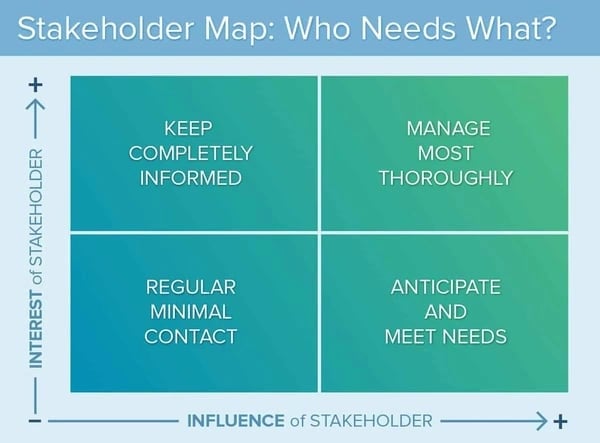
Image Source
The above stakeholder mapping exercise asks you to plot leaders on a two-by-two grid. One axis is labeled power and the other interest.
On the power axis, you rate each stakeholder on their ability to influence the project. On the interest axis, you rate each stakeholder on their level of interest in the project. This will give you a clear picture of which stakeholders are the most important to engage with and how best to do so.
There are several different ways to map stakeholders, including:
- RACI matrix. This is a popular stakeholder mapping method that uses the letters R (responsible), A (accountable), C (consulted), and I (informed) to rate stakeholders on their level of involvement in the project.
- Power/interest grid. This is a simple way to map stakeholders that can be used to prioritize engagement. It is also known as the Salience model.
- Influence/impact matrix. This is a more detailed stakeholder mapping method that can be used to assess the potential impact of each stakeholder on the project.
3. Assess stakeholder needs and interests.
The key to a successful stakeholder management plan is understanding your stakeholders. This will help you assess what they want from the project and how best to engage with them.
At this stage, ask yourself the following questions.
- Do you understand their needs, priorities, and issues?
- Do they have the power to influence the project?
- What financial or emotional interest do they have in the outcome of the project?
- What motivates them?
By understanding the answers to these questions, you can better develop a stakeholder management plan that fits each leader.
4. Define stakeholder motives.
Once you've identified and assessed your stakeholders, you can begin to define their motives. This will help you understand what they want from the project and how best to engage with them.
There are several ways you can define stakeholder motives, including:
- Interviews. You can interview stakeholders to get their views on the project. This can be done in person, over the phone, or via email.
- Surveys. You can send out surveys to stakeholders to get their feedback on the project. This is a quick way to gather data from a large number of stakeholders.
- Focus groups. You can hold focus groups with stakeholders to get their input on the project. This can be used to generate ideas and identify issues.
By understanding stakeholder motives, you can develop an effective stakeholder management plan that meets their needs and interests.
5. Develop a plan for engagement.
The goal of stakeholder engagement is to manage expectations and build relationships. This can be done through several different methods, including:
- Frequent communication. This is the most important aspect of stakeholder engagement . You must regularly communicate with stakeholders to update them on the project and get feedback. This can be done through face-to-face meetings, phone calls, emails, or online tools like a project management software . Each stakeholder may need their own communication strategy.
- Consultation. This involves consulting stakeholders in decision-making. This can be done through meetings, surveys, or focus groups.
- Collaboration. This involves working with stakeholders to complete tasks or achieve objectives. This can be done through co-creation, joint planning, or shared decision-making.
The best way to engage with various leaders will depend on the stakeholder and the project. You should tailor your engagement plan to each individual.
Stakeholder Management Plan Templates
After you’ve identified stakeholders, it’s time to develop management plans for each group.
The below templates can help you create engagement plans and organize your stakeholder communication.
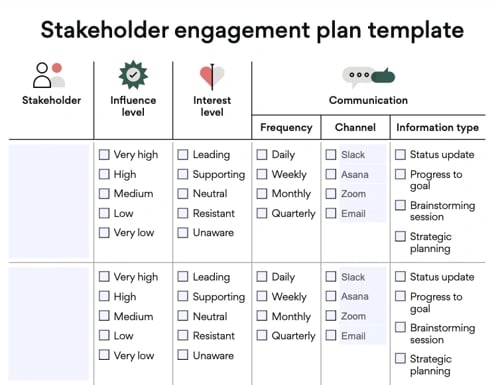
If you’re new to stakeholder management, this template from Asana offers a simple way to stay organized. In this plan, you write down each stakeholder, their level of interest in your project, and how influential they are to your work.
Then, you can check a box to identify their communication preferences. That includes how often they want to hear from your team and how they want you to get in touch.
What we love: With this template, you know which of your leaders prefer a quick Slack versus a formal email at a glance.
Project Management Docs
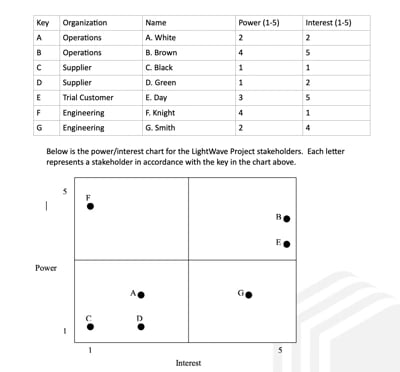
If you’re looking for a more detailed engagement plan, consider this option from Project Management Docs. With this document, you can fully lay out the vision of your project and which departments your initiative will affect.
What we love: This template includes charts and tables that you can use to determine each stakeholder's level of importance to your project. You can use this document to brainstorm and outline your final draft.
KnowledgeHut
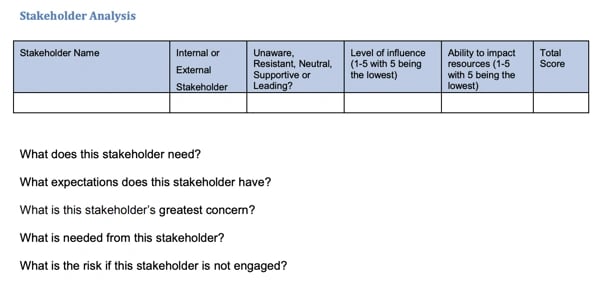
If you’re looking for a complete guide to writing an engagement plan, KnowledgeHut is here to help. This template includes sections that help you identify stakeholders and create a timeline for each person’s involvement. You can also keep track of costs and human resources involvement.
What we love: This template features charts that you can fill out with stakeholder data. If you get stuck, each section comes with helpful questions for self-reflection to guide you along the way.
PM-Training
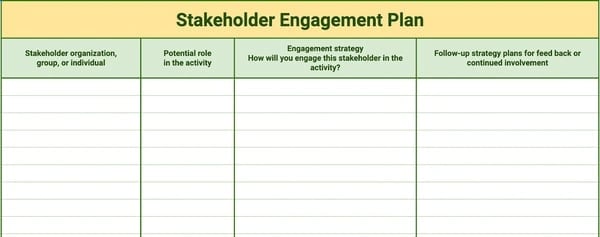
If you’ve been searching for a simple spreadsheet to manage your stakeholders, look no further. This template from PMTraining offers a straightforward approach to managing stakeholders.
What we love: This template lays out who is involved, what they need to do for your project, and how you plan to keep them engaged. If you’re looking for a quick way to develop a one-page stakeholder management guide, this is it. Plus, everything can be edited in Google Docs.
Formalizing stakeholder management can feel like an overwhelming process. Whether you’re just getting started or have years of experience, the following tips can help you ensure successful stakeholder management.
1. Define the purpose of the project.
According to PMI, 44% of projects fail because of a lack of alignment between business and project objectives.
Before you begin engaging with stakeholders, it is crucial to define the purpose of the project. This will help you identify who you need to engage with and their objectives.
2. Define roles and responsibilities.
At the start of a project, clearly define each stakeholder's roles and responsibilities. This will help ensure that everyone is clear on their involvement in the project.
3. Communicate regularly.
Regular communication is essential for successful stakeholder management. You should update stakeholders on the project regularly and solicit their feedback.
Your strategic objectives should always be clear in stakeholder communication. This allows your team to manage stakeholder expectations and create positive relationships.
4. Be transparent.
It is important to be transparent with stakeholders about the project. This will help build trust and ensure everyone is on the same page.
5. Seek feedback.
Feedback is essential for successful stakeholder management. You should seek feedback from stakeholders at every stage of the project.
Keep track of their suggestions and implement their insights. You can then report back on how you implemented their solutions to further gain their support.
6. Choose the right software.
Today, only one in four teams uses a project management software. Implementing one of these tools can help you keep organized.
That ranges from project management software, like Basecamp or Asana, to collaboration software, like Google Drive or Trello. Choose a tech stack that best fits the needs of your project.
7. Be flexible.
Stakeholder management is not a one-size-fits-all process. You should be flexible and tailor your approach to each individual you work with.
Create an Effective Stakeholder Management Plan
Stakeholders hold the power to influence your project, so engaging leaders while keeping their needs at the forefront will help keep things running smoothly.
Keep these tips in mind as you develop your stakeholder management strategy to stay on track.

Don't forget to share this post!
Related articles.

Process Documentation Writing Tips
![importance of business plan to stakeholders How to Write a Creative Brief in 11 Simple Steps [Examples + Template]](https://blog.hubspot.com/hubfs/creative-brief_2.webp)
How to Write a Creative Brief in 11 Simple Steps [Examples + Template]

The 5 Phases of Project Management

The Complete Guide to Project Management Basics

What is a Project Charter? The Complete Guide

Program Management Vs. Project Management: What You Need To Know
![importance of business plan to stakeholders The Business Requirement Document: What It Is and How to Write It [+5 Templates]](https://blog.hubspot.com/hubfs/what-is-a-business-requirement-doc.jpg)
The Business Requirement Document: What It Is and How to Write It [+5 Templates]

Everything You Need to Know About Using the Waterfall Methodology

Scope Creep Is Killing Your Bottom Line: Here's How to Prevent It
![importance of business plan to stakeholders The Evolution of Project Management [Infographic]](https://blog.hubspot.com/hubfs/00-Blog_Thinkstock_Images/project-management-evolution.png)
The Evolution of Project Management [Infographic]
Plan, manage, and analyze your projects with this free template.
Marketing software that helps you drive revenue, save time and resources, and measure and optimize your investments — all on one easy-to-use platform
Maximizing Value: The Power of Stakeholder Strategies
- September 20, 2023
- Business Strategy & Innovation

In today’s dynamic business landscape, maximizing value through stakeholder strategies is crucial for companies seeking long-term success. By prioritizing the needs and interests of all stakeholders, rather than solely focusing on shareholders, CEOs can create sustainable and resilient businesses.
Through a data-driven approach, firms can design and implement effective stakeholder engagement strategies. By harnessing outside perspectives and understanding interdependencies, companies can build innovative and forward-thinking organizations.
This article explores the power of stakeholder strategies, providing actionable insights and success stories to inspire and drive innovation in business practices.
Table of Contents
Key Takeaways
- Recognizing the limitations of creating value only for shareholders
- Importance of exploring outside perspectives and understanding interdependencies
- Stakeholder strategies reduce risks of customer defections, employee turnover, and loss of shareholder confidence
- Data-driven approach to stakeholder strategies using data from agencies like the Drucker Institute and Just Capital
Recognizing the Importance of Stakeholder Strategy
CEOs are recognizing the limitations of creating value only for shareholders and pledging to generate benefits for all stakeholders. This shift in mindset is crucial for businesses, especially small ones, as they navigate an ever-changing and competitive landscape.
Implementing stakeholder strategies in small businesses is essential to their long-term success and growth. By incorporating stakeholder perspectives in decision making, businesses can better understand the needs and expectations of their customers, employees, suppliers, and the wider community. This approach allows for more informed and strategic decision making, leading to innovative solutions and improved overall performance.
Small businesses that prioritize stakeholder strategies not only build stronger relationships with their stakeholders but also gain a competitive advantage in the market. Incorporating stakeholder perspectives is a powerful tool for small businesses to drive innovation, foster growth, and create value for all stakeholders involved.
CEOs’ Pledge to Benefit All Stakeholders
Companies are increasingly recognizing the need to prioritize the benefits of all stakeholders, as evidenced by their pledge to generate value for everyone involved. This stakeholder-centric approach is gaining momentum as businesses realize the limitations of solely focusing on shareholder value.
To effectively implement stakeholder engagement strategies, firms must use data-driven approaches to design and measure the impact of their strategies. By exploring outside perspectives and understanding interdependencies, companies can create more successful and resilient businesses.
Moreover, a stakeholder-based approach not only reduces risks of customer defections, employee turnover, and loss of shareholder confidence, but also makes leadership roles more meaningful and rewarding.
To ensure the success of stakeholder strategies, companies should use better tools for measurement, such as improved data availability, standardized ways of measuring impact, and independent rating agencies conducting sophisticated analyses of stakeholder interests.
Creating Explicit Strategies for Stakeholder Engagement
Recognizing the need for effective stakeholder engagement, businesses are now taking steps to create explicit plans that prioritize the benefits of all involved parties. This shift is driven by the realization that measuring stakeholder impact is crucial in achieving long-term success.
However, there are challenges in stakeholder engagement that organizations must address. One challenge is defining value. There is ongoing debate on what constitutes value and how to adopt stakeholder-centric approaches. Another challenge is scaling up. Many companies rely on intuitive strategies, but struggle to scale them up and sustain their impact. Additionally, a data-driven approach is necessary. By using data to craft and implement growth strategies, businesses can overcome these challenges and ensure meaningful engagement with stakeholders.
To navigate these challenges, organizations must leverage innovative tools and methodologies to measure stakeholder impact accurately. This will enable them to create explicit strategies for stakeholder engagement that drive sustainable value creation and establish themselves as leaders in their industries.
Leveraging Data for Effective Stakeholder Strategies
By leveraging data, organizations can design and implement effective strategies that prioritize the needs and interests of all stakeholders involved. Using data to measure stakeholder impact is crucial in understanding the value created for each group and identifying areas for improvement.
Implementing data-driven growth strategies allows organizations to make informed decisions and allocate resources more efficiently. Data provides valuable insights into customer satisfaction, employee engagement, and the impact on communities, enabling organizations to align their strategies with the interests of these stakeholders.
By incorporating data into their decision-making processes, organizations can identify trends, predict future outcomes, and identify opportunities for innovation. This analytical and strategic approach not only strengthens the organization’s relationship with stakeholders but also enhances its overall performance and competitiveness.
Organizations that embrace data-driven stakeholder strategies are better equipped to navigate the complexities of the modern business landscape and foster innovation and growth.
Exploring Outside Perspectives and Interdependencies
Exploring outside perspectives and understanding interdependencies allows organizations to gain valuable insights and foster collaboration among stakeholders. This approach encourages innovation and brings in fresh ideas that may have been overlooked within the organization.
By exploring diverse perspectives, organizations can tap into a wider range of knowledge and experiences, leading to more innovative solutions and a better understanding of the needs and desires of various stakeholders.
Understanding dependencies is equally important, as it allows organizations to identify the interconnectedness between different stakeholders and how their actions can impact one another. This knowledge enables organizations to make more informed decisions and develop strategies that consider the interests and concerns of all stakeholders involved.
Ultimately, embracing diverse perspectives and understanding dependencies can lead to a more inclusive and successful stakeholder strategy.
Business as a Unifying Force in Society
Companies that prioritize the well-being of all stakeholders have the potential to serve as unifying forces in society and shape more-balanced policies on various issues. By actively collaborating with stakeholders, businesses can foster social cohesion and address the complex challenges of our time.
Through stakeholder collaboration, companies can tap into diverse perspectives, insights, and expertise to drive innovation and create sustainable solutions that benefit everyone involved. This approach not only enhances the overall well-being of society but also contributes to the long-term success and resilience of the business itself.
Building Successful and Resilient Businesses Through Stakeholder Prioritization
Using a data-driven approach and prioritizing the needs of all stakeholders, businesses can build successful and resilient operations. By maximizing value through stakeholder collaboration and embracing long-term sustainability through stakeholder engagement, companies can achieve sustainable growth and innovation.
Here are three key strategies to consider:
Utilize data to understand stakeholder perspectives and interdependencies, enabling the identification of value creation opportunities.
Develop explicit strategies for stakeholder engagement, recognizing the importance of creating benefits for all stakeholders, not just shareholders.
Measure and evaluate progress in value creation for each stakeholder group, using standardized metrics and independent rating agencies to ensure transparency and accountability.
Reducing Risks Through Stakeholder Strategies
To mitigate potential risks, businesses can implement stakeholder strategies that prioritize the needs and interests of all involved parties. By identifying stakeholder needs and measuring stakeholder impact, companies can effectively reduce the risks of customer defections, employee turnover, and loss of shareholder confidence.
This data-driven approach allows businesses to make informed decisions and design interventions that address the concerns of various stakeholders. By incorporating outside perspectives and understanding the interdependencies between stakeholders, companies can proactively manage potential risks and ensure the long-term success and resilience of their businesses.
Furthermore, by prioritizing all stakeholders, businesses can create a more meaningful and rewarding leadership role, fostering innovation and driving positive change. By measuring the value created for each stakeholder group, companies can demonstrate their commitment to sustainable growth and build trust with their stakeholders.
Making Leadership Roles Meaningful and Rewarding
By prioritizing the needs and interests of all stakeholders, leaders can create a more meaningful and rewarding role that fosters innovation and drives positive change. This leadership transformation is essential in today’s dynamic business environment, where employee satisfaction plays a crucial role in organizational success.
To achieve this transformation, leaders must focus on three key areas:
Empowering Employees: Providing opportunities for growth and development, encouraging autonomy and creativity, and fostering a supportive and inclusive work culture.
Building Trust: Establishing open and transparent communication channels, actively listening to employees’ concerns and ideas, and appreciating their contributions.
Recognizing and Rewarding Performance: Implementing fair and effective performance evaluation systems, offering competitive compensation and benefits, and acknowledging and celebrating achievements.
A Data-Driven Approach to Stakeholder Strategies
Data from agencies like the Drucker Institute and Just Capital bolster companies’ efforts to design and implement effective stakeholder strategies. By utilizing data-driven decision making and incorporating stakeholder engagement metrics, companies can gain valuable insights and make informed strategic choices.
This analytical approach allows businesses to identify key stakeholders, understand their needs and expectations, and develop strategies that maximize value for all parties involved. Data-driven stakeholder strategies enable companies to measure the impact of their actions on various stakeholder groups, ensuring that they are creating value and fostering positive relationships.
Moreover, this approach provides a framework for evaluating progress and making necessary adjustments to align with stakeholder interests. By utilizing data and metrics, companies can enhance their stakeholder strategies, drive innovation, and ultimately achieve greater success in today’s rapidly evolving business landscape.
Frequently Asked Questions
What are some common challenges in implementing stakeholder strategies.
Some common challenges in implementing stakeholder strategies include defining value, ensuring a stakeholder-centric approach, relying on intuition versus specific criteria, and scaling up and sustaining intuitive strategies. Best practices involve using data to craft and implement growth strategies.
How Can Companies Measure Their Impact on Stakeholders?
Companies can measure their impact on stakeholders by evaluating the effectiveness of their strategies and measuring the value created for each stakeholder group. This data-driven approach allows for better decision-making and innovation in maximizing stakeholder value.
Are There Any Standardized Methods for Measuring Financial Results and Shareholder Returns?
Standardized metrics and ROI measurement are essential for companies to accurately measure their financial results and shareholder returns. These tools provide a clear framework for evaluation and enable strategic decision-making based on data-driven insights.
Can You Provide Examples of Companies That Have Successfully Implemented Stakeholder Strategies?
Examples of companies successfully implementing stakeholder strategies include those that prioritize all stakeholders, build resilient businesses, and reduce risks. These companies create consistent value for multiple stakeholders, delivering high shareholder returns and outperforming industry indices.
How Can Stakeholder Strategies Help in Reducing Risks Such as Customer Defections and Employee Turnover?
Stakeholder strategies, like a shield against risks, reduce customer defections and employee turnover. By engaging stakeholders, companies build trust, address their needs, and create a sense of purpose, leading to increased loyalty and retention.
- Professional Services
- Creative & Design
- See all teams
- Project Management
- Workflow Management
- Task Management
- Resource Management
- See all use cases
Apps & Integrations
- Microsoft Teams
- See all integrations
Explore Wrike
- Book a Demo
- Take a Product Tour
- Start With Templates
- Customer Stories
- ROI Calculator
- Find a Reseller
- Mobile & Desktop Apps
- Cross-Tagging
- Kanban Boards
- Project Resource Planning
- Gantt Charts
- Custom Item Types
- Dynamic Request Forms
- Integrations
- See all features
Learn and connect
- Resource Hub
- Educational Guides
Become Wrike Pro
- Submit A Ticket
- Help Center
- Premium Support
- Community Topics
- Training Courses
- Facilitated Services
How To Create the Perfect Stakeholder Management Plan
April 19, 2022 - 7 min read
A stakeholder management plan is a strategy document that will help you ensure project deliverables and expectations align and that your project is seen as a success. Without a plan to regularly update stakeholders, resources, funding, employees or materials can be impacted.
Learning how to create the perfect stakeholder management plan can be difficult, so within this article, we’ve explained in detail what should be included in a stakeholder management plan, who should write the document, and what might happen if you choose not to make one.
We’ve also built a handy communication plan template that makes creating a stakeholder management plan simple and straightforward. It will help you keep stakeholders informed and aligned with a regular series of communications.
What is a stakeholder management plan?
A stakeholder management plan is a written document that outlines how your team plans to manage the goals and expectations of key stakeholders during the project lifecycle.
What are stakeholders ? A stakeholder is anyone who might be impacted by your project or has a business interest in how your project turns out. Common stakeholders include:
- Project team members
- Project sponsors
- Company executives
- Clients and customers
- End-product users
- Suppliers and vendors
- Contractors
- Community members
Key project stakeholders are stakeholders who not only have an interest in the project outcome but also have the power to influence communication plans , policy, and other procedures. This influence can be exercised through levels of participation, review cycles, and more.

Typically, key stakeholders include your client, project team, sponsor, resource managers, and executive committee.
Project stakeholder management involves creating a stakeholder management strategy that addresses expectations, resolves conflicts, and ensures stakeholder needs are met.
An effective stakeholder management plan also typically identifies vital information about your key stakeholders and outlines your strategy and plan for managing each one.

Who creates a stakeholder management plan?
The project manager usually creates the stakeholder management plan. However, that doesn’t mean the PM completes it in isolation. You must gather input from everyone involved in your project to identify the key stakeholders and assess their needs, expectations, and level of influence.
What is covered in a stakeholder management plan?
The primary components of a stakeholder management plan are:
- Prioritization of stakeholders: Rank stakeholders based on their ability to influence your project and how much they care about its outcome.
- Stakeholder expectations: You cannot manage expectations if you don’t know what they are. You must document everything, including how they prefer to communicate and what they want to be involved with.
- Communication rules: The plan should outline the level, frequency, and type of communication with each stakeholder as well as who on the team is their point of contact.
- Action plans: This is the meat of your plan — It’s where you outline how you will manage stakeholder involvement and what steps to take to ensure expectations are met.

Why is a stakeholder management plan important?
Effective stakeholder management is critical to a project’s success. Key stakeholders often have control over project resources, such as project funds, employees, materials, or knowledge critical to its success.
A documented stakeholder management plan of action ensures your stakeholders’ interests and expectations are understood so that you can properly manage them. A plan enables you to articulate to a project team how communication will work, including who will be told what and when.
Going through the process of creating a plan also helps you analyze your stakeholders and better understand them. This can help you better anticipate their needs and proactively address any concerns.
What happens if you don't have a stakeholder management plan?
If key stakeholders aren’t engaged, or worse, if they’re actively working against your project, your chances of failure drastically increase.
Successfully dealing with difficult stakeholders requires knowledge of what motivates them. Without a stakeholder management plan , you may not understand the underlying factors driving them, meaning you will be unsuccessful in getting them on your side.
Plus, without having assessed and prioritized your stakeholders in your stakeholder management plan, you could waste a lot of time dealing with stakeholders with little power while overlooking those with the authority to tank your project.
Top tips for how creating a stakeholder management plan
Here are eight tips for how to create the perfect stakeholder management plan:
- Use a template: A stakeholder management template guide or a pre-built RACI template will save you time creating your plan, ensure no information fields are overlooked, and create consistency, as every stakeholder plan in your company will look the same.
- Start early: Key stakeholders can influence your project before it’s even off the ground. Identifying and involving stakeholders early can make all the difference to their level of engagement and your success.
- Update regularly: Stakeholders change throughout your project. Some may leave positions while others may join. Plus, their level of engagement and expectations may evolve as time goes on. Review your plan at least monthly to ensure it’s up-to-date.
- Ensure transparency: Transparency builds trust, and when you have your stakeholders’ trust, you’re much more likely to have their cooperation and support. When creating your communication guidelines in your plan, keep in mind that open, frequent, two-way communication creates project transparency.
- Make priority clear: Including a grid or matrix of stakeholders based on interest and influence can help you quickly see and understand where to focus your efforts.
- Be concise: For your plan to be successful, you need to get to the root of what people care about and document it in concise, easy-to-understand terms that anyone who reads it can grasp.
- Plan for conflict: You will inevitably have stakeholders with conflicting needs. Be proactive about how you will resolve issues and document this approach in your plan so that everyone is aware of it beforehand.
- Publish it: Your stakeholder management plan shouldn’t be a secret. Store it somewhere accessible and share it with stakeholders. Not only does this increase transparency, but it also helps ensure no stakeholders or key factors were overlooked.

Sample stakeholder management plan template
It can be difficult to know where to begin when it comes to creating a stakeholder management plan of your own. Here is a simple template to refer back to when you need a helping hand. In this example, the project in question is a new email marketing campaign involving a number of stakeholders across the wider marketing team.
While this is a basic template to help you fill your own, it makes much more sense to use a collaborative work management platform like Wrike to involve all your stakeholders in a single source of truth on all projects.
How to plan a stakeholder management strategy with Wrike
It can be difficult to keep track of your stakeholder management plan and ensure it’s accessible to those who need it. Not only does Wrike help companies create this type of strategy, our powerful work management software gives you a single location for your stakeholder management plan so it can be located easily
Because we know that creating these documents from scratch can be time-consuming, we’ve created a communication plan template guide and a pre-built RACI template that are the perfect places to start when planning your stakeholder management strategy.
With Wrike, you can plan and execute your stakeholder management strategy all in one place. Sign up for a free trial today and discover how it will improve your stakeholder management!

Jessica Everitt
Jessica is a former contributor of Wrike, specializing in project management topics.
Related articles

Why Is a Business Impact Analysis Important in Project Management?
A business impact analysis will identify and outline the costs of business or project disruption. Create an effective project impact assessment with Wrike today.

How to Get Stakeholders on Your Side With Campaign Transparency
Project transparency is key for keeping clients up-to-date with project and campaign progress. Find out the importance of stakeholders in a project and how to get them on your side with Wrike.

Tips for Conducting a SWOT Analysis in Project Management
How can SWOT analysis in project management help your next initiative? Learn more about the purpose of SWOT and how it can improve your projects today.

Get weekly updates in your inbox!
You are now subscribed to wrike news and updates.
Let us know what marketing emails you are interested in by updating your email preferences here .
Sorry, this content is unavailable due to your privacy settings. To view this content, click the “Cookie Preferences” button and accept Advertising Cookies there.
alva is now Penta. We are the world’s first comprehensive stakeholder solutions firm. Learn More
Hit enter to search or ESC to close

- Stakeholder Intelligence
- Knowledge Centre
- Case Studies
- White Papers
- Sector Rankings
- Job Openings

Why is stakeholder management important?
In a world where the importance, influence and impact of myriad stakeholder groups is becoming ever greater, businesses need to be able to manage their relationships with those stakeholders. Having an effective stakeholder engagement plan creates competitive advantage, cements customer loyalty, and renews the social contract
What is stakeholder management?
Stakeholder management is the process of nurturing reciprocally beneficial relationships between a business and its stakeholders. The creation of shared value for all parties.
Each group of stakeholders, from employees to investors, customers, the media and suppliers, is identified and characterised. Their needs and expectations are evaluated. And a stakeholder management strategy is established.
Few things are truly simple, however, and the practice of stakeholder management can become quite complex, requiring the employment of intelligent management tools and solutions . Stakeholder mapping is the start of the process. This allows a business to understand who its various stakeholders are, the health of its existing relationships, and the relationships it aspires to have.
Each group might be ranked against its influence, interest and impact on the business and its activities. This type of stakeholder analysis will help a business to map the relationship stakeholder groups have to each other, as well as to itself, and strategise how to prioritise each. The result is a stakeholder management plan.
As an aside, although in common usage, the term ‘management’ is not entirely appropriate in this context. No organisation has the ability to overtly manage – read control – their stakeholders. Customers have the freedom to go elsewhere, employees can quit, investors can sell up. A more accurate term would be stakeholder influencing, which better reflects process of listening to, understanding, engaging with stakeholders and responding in an informed manner.
The result is a stakeholder engagement plan . To be effective, this needs to align the priorities of different stakeholder groups with what’s right for the business. Leadership should be clear on what the purpose of the company are, and how it aims to achieve and honour them. This then informs its approach to managing stakeholder expectations in a transparent, authentic way. This isn’t about trying to please everyone all the time.
How will you impact tomorrow?
Risk Intelligence
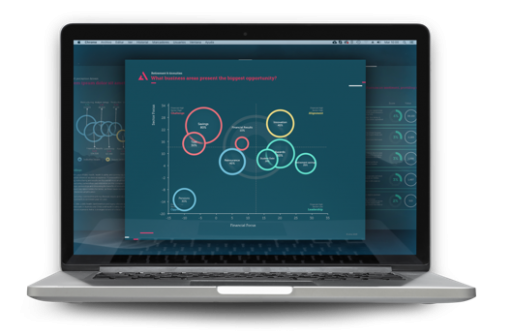
Why stakeholder management is important
No organisation is an island. The way it does business impacts a broad spectrum of individuals and groups. In 2021, a new era of stakeholder capitalism is gaining traction and represents a shift away from the tenet that the shareholder is always king.
Its guiding principle is that business activity should create shared social and economic value for all stakeholders, and society as a whole. The endgame is sustained value creation for all.
Against this backdrop of greater shareholder-centricity, it has never been more important to understand and respond to the needs of all stakeholders. With the hyper-connectedness of the modern world, one employee’s opinion can quickly shape the opinion of others.
NGOs can easily expose the climate-damaging behaviour of a particular business. Regulators are demanding ever-greater levels of corporate compliance and standards of business ethics. There is an expectation for corporate behaviours to support the good of society, not just the good of the P&L sheet.
Why stakeholder management matters to your business
The ability to engage with, speak to, and if necessary, diffuse the negative perceptions of your company’s stakeholders is inextricably linked to its success. Thanks to social media, each one has a public platform, and what they have to say can have a direct impact on your business.
Done well, stakeholder management can create a virtuous circle.
By focusing on the issues of high interest to their stakeholders, companies can engender goodwill, expand their business and improve their bottom line. The growing focus on ESG (environmental, social and governance) issues among investors, consumers and employees has given companies an opportunity to grow their stakeholder capital by being proactive in these areas.
Making commitments around sustainability, corporate social responsibility and good governance, and being a force for good in society can endear them to stakeholder groups. Particularly those which might previously have regarded them with mistrust – campaigning NGOs, for example.
That trust is fragile, however. With ambitious intentions come greater expectations, and a harsher backlash if you fail to live up to them. There is greater opportunity for firms to be called out by their stakeholders when their actions don’t match their declarations. Staying close to stakeholders, and understanding how quickly their opinions can shift, is vital to avoid falling foul of them.
The lesson here is to avoid hypocrisy. ESG commitments, and any other management strategies undertaken to appease stakeholders, need to avoid spin and be authentic.
Stakeholder management cannot be a PR exercise.
The benefits of stakeholder management
There are benefits to stakeholder management beyond diluting the vitriol of dissatisfied stakeholders.
Proactively developing and maintaining relationships with influential individuals and communities will garner increased stakeholder support. This could make the difference between getting planning for a new plant or being unable to expand your business. It can reduce risk, and increase opportunities, because you know what your stakeholders are saying about you as they say it.
This could boost a brand that manages to reach out to consumers just as their positive media coverage peaks. Or even result in the creation of a new product or service at the very moment there is a demand for it.
This type of proactive stakeholder management can reduce business costs and maximise the value of communications strategies. It can boost corporate reputation if your company is being seen to do the right thing by its stakeholders.
It can improve corporate governance if you recognise what your employees feel about the business and how to engage them. It can increase competitive advantage, putting you one, or more, steps ahead of the rest of your sector.
Perhaps most importantly in this era of stakeholder capitalism, it reaffirms your organisation’s contract with society, thereby renewing your social licence to operate.
The principles of stakeholder management
A stakeholder engagement plan will be unique to your business, and should be developed with a clear view of the business’s purpose and its stakeholders’ priorities. View the following principles through that lens.
- Managing risk: Stakeholder management is an important part of your corporate risk management strategy. If stakeholders aren’t viewed as sources of both risk and opportunity, those risks and opportunities might be missed.
- Prioritising: Inevitably, some stakeholders will have a greater influence and potential to impact your business than others. Establish which are the most important stakeholders in relation to particular areas of your businesses, and weight their expectations accordingly using a power interest grid.
- Communication: In order to be positively engaged, stakeholders need to understand the impact of corporate actions and the reasons behind them. Communicating with stakeholders effectively requires an understanding of the channels that will reach different groups. This is not a one-time activity. Borrow from the world of project management with a project plan and a project sponsor for each project stakeholder to ensure regular engagement.
- Building relationships: Be conscious of who your stakeholder groups are and how you connect with them. This builds trust, reduces uncertainty, and makes them more likely to positively support future activities. Communication should be direct, timely, and truthful and wording and imagery needs to be targeted to appeal to them.
- Consultation: The most accurate way to understand how stakeholders perceive a given topic is to ask them. Regular consultation will open up dialogue, make stakeholders feel that their priorities are acknowledged, and achieve a resolution which is acceptable to all.
- Factoring in human frailty: Stakeholder behaviours may not be rooted in logic. Sentiments formed about a product, service or behaviour could be a visceral rather than rational reaction. Assess the actual cause of stakeholder opinion to understand it better.
Related posts

What are the impacts of stakeholders on a business?

Stakeholder engagement: definition and strategies

ESG Performance: Challenges and solutions in quantifying ESG opportunities and risks Download this case study

Be part of the Reputation Community Join our Newsletter
alva, multi-award winner in 2021 ‘Artificial Intelligence Excellence’ and ‘AI & Machine Learning’ awards

- Our Approach
- Strategic Alignment
- Strategy Implementation Support
- Aligned Strategy Course
- Successful Strategy Implementation Course
- Strategy and Leadership Community
- Strategy and Leadership Podcast
- SME Strategy on Youtube
What is Stakeholder Engagement, and Why is it Important for Strategic Planning?
By Jenna Sedmak - March 11, 2021

Engaging stakeholders is crucial for successful strategic planning. It involves identifying, understanding and involving people who have a stake in the outcome of the plan. Effective stakeholder engagement management requires a comprehensive approach that includes ongoing communication, listening, and collaboration. This article discusses the importance of stakeholder engagement in strategic planning and offers tips on how to effectively engage your stakeholders in the process.
What is Stakeholder Engagement & Why is it Important?
What is a stakeholder, mapping your stakeholders, stakeholder management for strategic planning.
BEFORE starting the strategic planning process
DURING the strategic planning process
After the plan has been developed/renewed, ongoing - while the plan is being implemented.
Stakeholder engagement is a process that organizations can follow in order to listen to, collaborate with, or inform (or a combination of all three) their existing stakeholders. This process entails identifying, mapping and prioritizing stakeholders to determine the best tactics for effective communication while making the best use of available resources.
Stakeholder engagement helps organizations to proactively consider the needs and desires of anyone who has a stake in their organization, which can foster connections, trust, confidence, and buy-in for your organization’s key initiatives. When done well, stakeholder engagement can mitigate potential risks and conflicts with stakeholder groups, including uncertainty, dissatisfaction, misalignment, disengagement, and resistance to change. When it comes to strategic planning , stakeholder engagement is critical. It’s important that your stakeholders understand why you exist, where you want to go, and how you’re going to get there. Furthermore, it’s essential that your KEY stakeholders (see our stakeholder mapping section below) are aligned with and bought into the strategic direction of your organization so they can become advocates that can help you achieve your mission and vision. Additionally, your stakeholders will have a wealth of relevant knowledge and experience that your senior leaders may want to take into consideration to help your organization be more impactful, sustainable and viable over the long-term.
Stakeholders are specific groups of people (ex: not the general public), each with different desires and needs from the organization. A stakeholder is anyone who has a stake in your organization, either through interest, influence or both. Stakeholders can range from shareholders, to staff, board members, volunteers, funders, government, customers and beyond. note: Stakeholders and ‘publics’ are different subsets and require different communication strategies. While specific members of the public may be stakeholders, not all of them are. Publics are either unaware or aware of your organization but may lack both interest and influence at this stage. Some publics, especially aware publics, have the potential to become future stakeholders. For the purpose of this article, we are focusing solely on existing stakeholders.
Related Content:
Strategic Planning Process (What is it?)
How to Create Team Alignment and Why it's Critical in 2023
Through first mapping your stakeholder groups, your organization can develop a plan to engage with each group in a way that works best for them. This will help your organization to make the best use of your resources by not over communicating with groups that do not require the same level of attention as your high interest and high influence group, and by making sure to engage your higher interest and influence groups in greater depth.
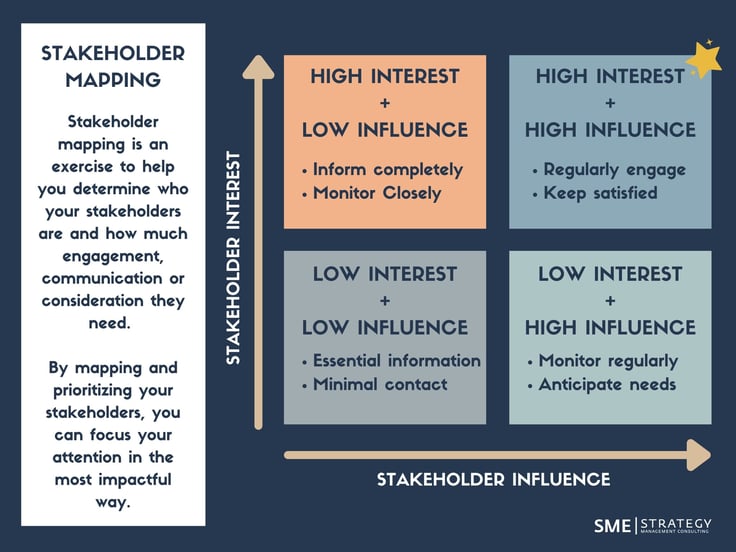
When mapping your stakeholders, group them into one of the four categories:
Low Interest & Low Influence For stakeholders with low interest and low influence, one-way communication of essential information will likely be sufficient in most instances.
Low Interest & High Influence This group is more influential than the low-low grouping. Although they still have a low interest in regular communication from your organization, it’s important to monitor this group regularly, keep them informed of critical information, and anticipate any interests or needs they may have.
High Interest & Low Influence This group is more interested than the low-low grouping. Although they may not be as influential as other stakeholders, you may wish to have regular, robust communication and consider two-way communication with this highly interested stakeholder group.
*High Interest & High Influence (these are your KEY stakeholders) This group is both interested and influential and will require more resources to engage with effectively. This is your priority grouping of stakeholders who will require regular, robust, two-way communication tactics to keep this group satisfied.
When determining how you will engage with each group, it’s important to remember to be inclusive. While some stakeholder groups will have different needs than others, it is also likely that individuals within stakeholder groups may also have different needs or desires than each other. Some considerations when developing an inclusive engagement plan may include: connectivity and device access, intercultural differences in communication styles or preferences, or accommodations due to age, ability, language, and otherwise. Note: Stakeholder mapping is not a one-time process. Stakeholder groups change and evolve alongside your organization. It’s important to review your stakeholder groups and update your stakeholder communication plans regularly - We recommend doing this annually, as a part of your strategy review process.
Prior to your strategic plan creation or strategy review, we recommend mapping (or re-mapping) your stakeholder groups to determine your groupings. Once you’ve identified your key stakeholders, the high-influence/high-interest grouping, determine if you have enough resources to engage in regular two-way communication with ALL of them prior to strategic planning, throughout the process, and on an ongoing basis afterwards. If you do not have the resources to engage with ALL of your high-high grouping of stakeholders, determine with your leadership team which ones are the MOST influential and the MOST interested. Pare the list down to the number of specific stakeholder groups that you can effectively engage in ongoing two-way communication. You will still need to communicate with the rest of these stakeholders, but you may use similar tactics as you would with some of the other stakeholder groupings that are less intensive than your key stakeholders. Once you’ve determined your key stakeholders for ongoing two-way communication (whether the entire list, or a pared down version) it’s time to determine how you will engage with them throughout the strategic planning process . You may communicate in the same way with all of these stakeholder groups, or you may determine that each group has different needs. While there is no single way to do this 'correctly', we’ve compiled some recommendations and options for managing your stakeholder communication with your high-priority stakeholder groups while developing and implementing your strategic plan:
(Download Now) Doing Stakeholder engagement as part of your strategic planning process soon? Ask your team these 15 questions first
BEFORE starting the strategic planning process with a strategy facilitator , consider the following:
Surveys - these can be used to help gather input from a wide variety of stakeholders prior to your strategy sessions for your leadership team to consider. This method may be less labor intensive than other two-way communication strategies. While this method will work for many stakeholders, others may wish for more comprehensive communication method.
Town Hall Sessions - these group sessions may include multiple stakeholder groups simultaneously, or may be devoted entirely to one stakeholder group, depending on their size or differing needs. These sessions can be held virtually or in person and offer an opportunity for a two-way discussion between key stakeholders and senior leaders prior to diving into the strategic planning process. This method allows you to engage multiple stakeholders simultaneously and have a structured, yet organic, conversation. While this method is time efficient, some stakeholders may wish for one-on-one interaction.
Interviews - these can be done one-on-one or in small groups (within one stakeholder subset and can be held virtually or in person. Interviews create an opportunity for a structured and open dialogue without the added "noise" of a group session. This method allows for a deeper conversation with key stakeholders and provides opportunities to really listen to their perspectives. While this method is highly engaging, it is time-consuming and may not be practical to undertake for all of your key stakeholders. If you prefer to facilitate your strategic planning process on your own, we have a variety of strategic planning tools available to help you get started!
Session Participation - While it is important to consult your key stakeholders throughout the strategic planning process, we don't recommend involving them all in your planning sessions. We recommend including only stakeholders with decision-making power in your strategy sessions. This will likely include your C-suite leaders and senior leadership team(s), and may potentially include board members or middle management, depending on the size of your organization and the scope of leadership duties.
Develop Communication Plan - Even though the rest of your stakeholders (in all four quadrants) will not be a part of your strategy sessions to create or revise your strategic plan, it is critical to devise a plan for how you will continually communicate with them on an ongoing basis. As recommended earlier in this article, your plan will need to include different tactics to engage different stakeholder groups, depending on their interest and influence. It will be of the utmost importance to prioritize your key stakeholders and make sure that they understand and are bought into the plan as early as possible.
Share your strategic plan - We recommend sharing your strategic plan with all of your stakeholders, regardless of which quadrant they are in. For those with lower interest or influence, you may choose to keep this high level by keeping your organization's vision, mission and values updated on your website. For those who are more invested in your plan's success, your key stakeholders, you will want to make sure that they have a deeper understanding and are aligned on your Vision, Mission, Values, Strategic Priorities, and Goals.
Town Hall Sessions - Holding another round of town hall sessions for your key stakeholders after you've revised or created your strategic plan is a great way to promote alignment and engagement. Beyond disseminating the information that is included in your plan, these sessions will allow for added clarity and context, and for stakeholders to understand more about how you will implement this plan and how they will contribute to the organization's success.
Implement your Communication Plan - After developing a communication plan as part of your organizational strategy, Remember, it is crucial to ensure its implementation in conjunction with your strategic plan. Set clear actions, deadlines, or intervals, and designate a responsible person (Chief Strategy Officer) if you have one, to ensure the completion of these actions. Our Strategic Planning Services emphasize our ability to assist organizations in effectively communicating and implementing their plans, encompassing the entire leadership team and extending to the frontline.
Proactively Follow your Stakeholder Map & Engage Your Stakeholders - This is a reminder that stakeholder engagement is continuous and ongoing. Make sure to be proactive and check in with your stakeholder map to make sure that your organization is continually meeting the needs of each of your stakeholder groups, especially your prioritized key stakeholders. Ongoing tactics may include newsletters, social media posts, website updates, quarterly town hall sessions, phone calls, site visits, among others.
We can help you engage and align your stakeholders,
s o you can lead your organization more effectively and get better results.

Our readers' favourite posts
Subscribe to our bi-weekly newsletter: leaders digest, quick links.
- Podcast (Spotify)
- Speaker & Media
- Alignment Book
- Privacy Policy
Free Resources
- Strategic planning session agenda (Sample)
- Strategic plan template
- How to create a strategic plan (Start here)
- Weekly Strategy Tips
- Non profit program
Products and Services
- Strategic Planning Facilitator
- Strategy Implementation Consulting
- Strategic Planning Course
- 1-855-895-5446

Copyright © 2011-2023 SME Strategy Consulting | Strategic Planning Facilitator + Strategy Implementation Consulting. All rights reserved.

What is stakeholder management?
Stakeholder communication: benefits, best practices, and management.
Stakeholder communication is an important skill for every project manager and organizational leader — whether they...

Stakeholder communication is an important skill for every project manager and organizational leader — whether they realize it or not.
Communicating effectively with your stakeholders can make all the difference when it comes to building strategic relationships, increasing your influence, making smarter decisions, and managing risk. On the other hand, if you find yourself dealing with low engagement, greater risk, missed opportunities, damage to your reputation, and even legal issues… poor stakeholder communication may be the culprit.
Ready to build your skills and knowledge in stakeholder communication? We’ve covered all the basics you need to know, along with some advanced tips and best practices to help you improve communication with your stakeholders.
What Is Stakeholder Communication?
Stakeholder communication refers to the methods organizations use to share information and engagement opportunities with stakeholders — the people and groups that are impacted by, have an influence on, or an interest in your project or organization.
It can also refer to the methods stakeholders use to reach an organization with questions, concerns, and feedback.
Common methods of stakeholder communication include:
- SMS messages
- Phone calls
- Face-to-face meetings or events
- Online chat messaging
- Social media content
- Blog/news content
Communication is an important part of stakeholder engagement and management , as it enables organizations and stakeholders to share information, manage expectations , and build a shared understanding.
What Are the Benefits of Stakeholder Communication?
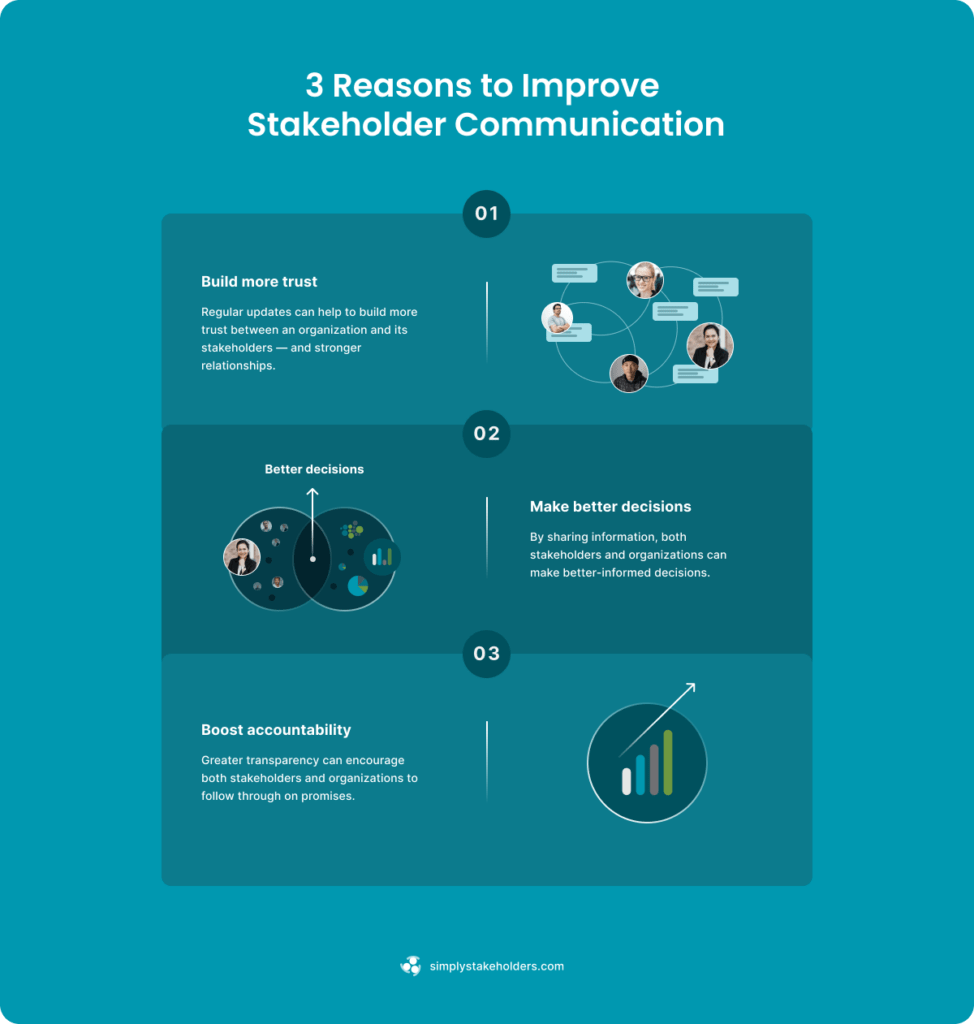
Chances are, you already communicate with some of your stakeholders, some of the time. But is it worth putting more resources towards improving your communication, honing your targeting, or reaching a larger stakeholder group? The benefits speak for themselves…
Building Trust
Firstly, stakeholder communication has a key role to play in building trust between an organization and its stakeholders. And trust is key to building strong stakeholder relationships — the kind of relationships that can deliver a lot of value to both parties.
Regular updates can demonstrate that an organization has nothing to hide, and visibility into the project, plans, and performance can help to create transparency and openness.
At the same time, showing up consistently with email updates, letters, and other forms of communication can help stakeholders trust the organization to deliver on their promises and respond to any questions and concerns.
Improving Decision-Making
Regular stakeholder communication can also support better decision-making — for both the organization and its stakeholders.
When you keep stakeholders informed and give them opportunities for two-way communication, their comments can have a genuine impact on your project (especially when you engage them early on in the project). On the other hand, if you only communicate with a small, select group of stakeholders, you risk missing important perspectives on the project, potential roadblocks you’ll need to overcome, and impacts on your project timeline.
For example, you could interview local residents to discover how they might use a proposed new road. But many of the road’s future users will also include families, school communities, and employees who are travelling from other areas. And their input on the project might reveal that in order for the road to be future-proof, it would need several key changes that residents had not mentioned, such as parking, wider areas, and links to an existing transit corridor.
Essentially, the more you know, the better your decisions can be.
Ensuring Accountability
Regular communication between an organization and its stakeholders can also help to improve accountability . This goes both ways — greater transparency and openness can help keep an organization accountable to its values and promises, but it can also keep stakeholders accountable to fulfil their part of the project.
For example, a project manager might need to manage several stakeholders that are involved in a construction project. By keeping in touch with those stakeholders on a daily basis via meetings, phone calls, or messages, they can check on progress, remind people about upcoming milestones, and keep the project moving forward.
Best Practices for Stakeholder Communication
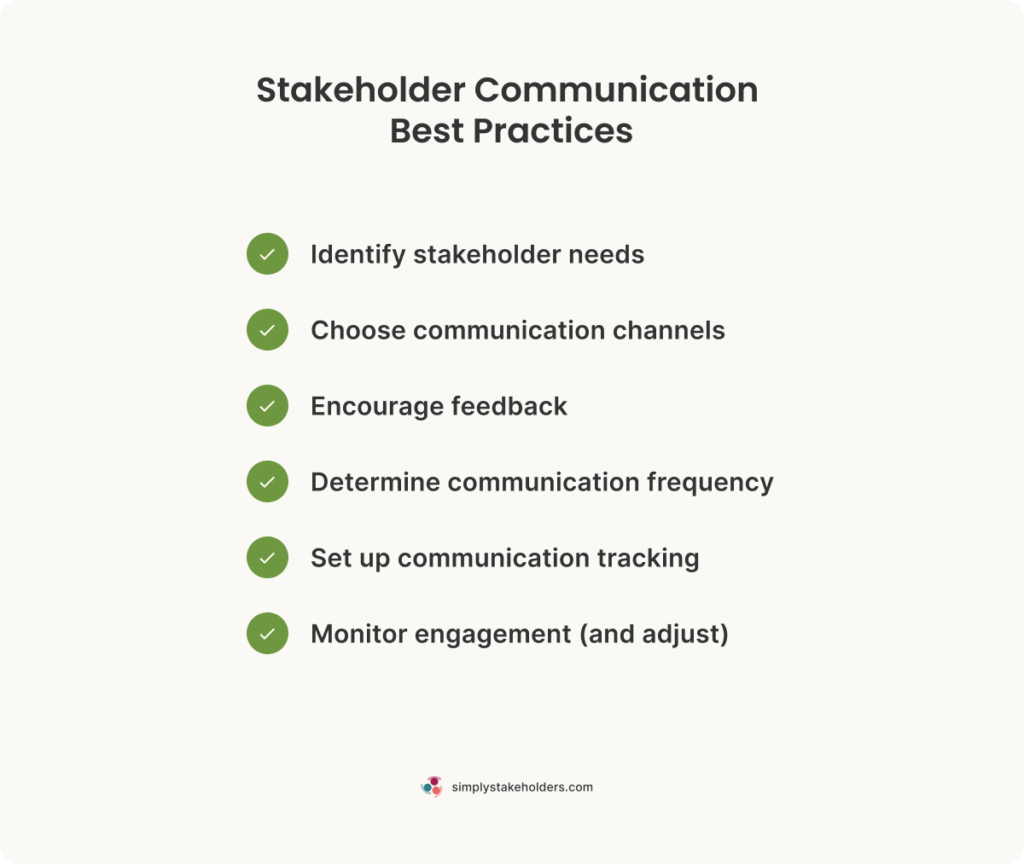
Ready for a more strategic and mature approach to your stakeholder communication? We’ve found that the following best practices can help any organization communicate more effectively with their stakeholders:
Identify Stakeholder Needs
First thing’s first: the better you know your stakeholders, the more effectively you’ll be able to communicate with them. Put yourself in their shoes and consider:
- What sort of communication do they want or need?
- How often might they want to hear from you?
- What are their goals?
- What issues do they care about?
- What do they expect from you?
- What’s relevant to them?
By only sharing relevant information, it’s more likely that your stakeholders will pay attention when they hear from you — and equally, more likely that they’ll respond to your communication.
If you haven’t already, now is a good time to conduct a stakeholder analysis and note down any relevant findings, such as the issues that each stakeholder is concerned about and any specific expectations they may have.
Choose the Right Channels
You can’t talk about stakeholder communication without addressing the elephant in the room — that these days, there are an ever-growing number of channels available for communicating with stakeholders. Most organizations don’t have the resources to communicate and manage responses on every channel. So, it’s important to be selective and choose the right channels.
During your stakeholder analysis, find out where your stakeholders prefer to receive communication, what type of communication they expect to receive on different channels, and how often they’d like to hear from you.
For instance, you might find these communication channels are suitable for the following types of communication:
- Email – Longer-form, regular updates about the project to interested stakeholders who are subscribed to receive updates (learn more about how to write engaging emails )
- SMS – Short updates about an immediate or last-minute event that impacts stakeholders
- Phone calls – Personalised meetings (as needed) to discuss the project with key stakeholders
- Social media content – Short updates or news with information that’s relevant and engaging for a broad range of interested stakeholders (learn more about using social media to engage stakeholders )
- Meetings or events – Presentations with information for key impacted/interested stakeholders, and opportunities to chat and ask questions one-on-one (typically held early on in the project)
- Direct message (e.g. Slack) – Sharing discussions and updates (as things happen) with internal staff and contractors who are involved in or have an influence on the project
In your stakeholder communication plan, note the channels you plan to use and how you plan to use them.
Encourage Feedback
Your stakeholder communication should leave plenty of room for feedback from stakeholders. This means providing multiple ways for stakeholders to get in contact (phone, email, face-to-face, messaging, comments, etc.), along with opportunities to participate in the project or engagement process. It could be as simple as sending out stakeholder surveys to get feedback on your plans, or you may host meetings, focus groups, and events where stakeholders can contribute their ideas and perspectives.
Stakeholder feedback will help you gain valuable insights into your stakeholders and project — as well as insights into how you can improve the engagement as you go (or in future).
Your stakeholders are likely to be busy people and short on time. So encourage them to leave feedback by:
- Engaging in conversation with your stakeholders
- Responding to their questions and comments
- Reporting back on what stakeholder feedback you’ve received
- Demonstrating how it has influenced your decision-making
Establish a Cadence
Consistency is key, and your communication with stakeholders should be regular and predictable. This is important to ensure your stakeholders receive timely updates about the project — and to build confidence that you will continue to show up.
When you’re planning your stakeholder communication, note down how often you plan to communicate via specific channels. It’ll depend on the channels you choose and how you use them, but as a general rule, the following cadence is typical for these channels:
- SMS – As needed for timely notifications or events
- Email – Weekly, fortnightly, or monthly updates
- Letters – Monthly or quarterly updates (or one-off updates)
- Events – Typically concentrated early on in the process, or at major milestones
- Social media – Aim for status updates every day or several times per week
- Phone calls or messages – Typically on an individual and as-needed basis
Once you establish a cadence for each channel, try to stick to it for the duration of the project.
Track All Communication
You should be tracking all your stakeholder communication in your stakeholder system. Depending on your organization and project, this may be a requirement for compliance, demonstrating that you have genuinely engaged with stakeholders. But tracking all the communication that goes out (and the responses you get from stakeholders) is also important to ensure you and your team have context for future stakeholder conversations and engagements, without having to rely on memory.
Having easy access to this past information (and referencing it) will:
- Demonstrate that you’re paying attention
- Help you keep your communication relevant
- Show that you genuinely care about your stakeholders
- Reduce the likelihood of repeating the same information/question twice
- Help you build stronger relationships with stakeholders
If you already have stakeholder relationship management software, make sure you keep an up-to-date record of all emails, messages, and conversation notes inside your software, attached to the relevant contacts.
Monitor Engagement
Finally, it’s important to regularly analyze your stakeholder communication so that you can refine your approach, focus your time on the most effective channels and messages, and apply your learnings to future engagements. Depending on how you’ve been communicating with stakeholders, this could involve looking at the level of engagement/shares on social media, email opens/replies, changes in sentiment over time, and more.
By the way, if you use Simply Stakeholders to manage your stakeholders, our AI-driven sentiment analysis can qualitatively analyze your stakeholder communication to determine how stakeholders feel about an issue!
A Better Way to Manage Stakeholder Communication

Looking for a tool to help improve your stakeholder communication? Simply Stakeholders is designed to simplify stakeholder management with features like contact records, analysis, stakeholder mapping, issues tracking, sentiment analysis, and integrations with communication tools.
Learn more about how it works or reach out to the team if you’d like to see our product in action.

About Us How It Works Pricing FAQ
Contact Resources Blog eBooks
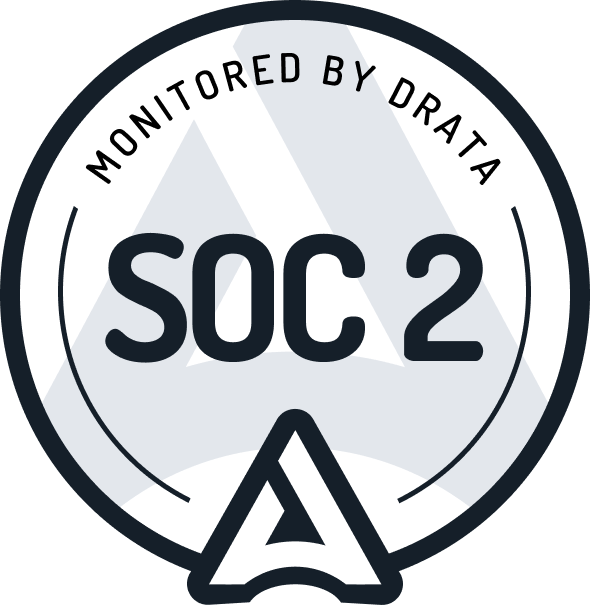
© 2023 Simply Stakeholders. All Rights Reserved.
.css-s5s6ko{margin-right:42px;color:#F5F4F3;}@media (max-width: 1120px){.css-s5s6ko{margin-right:12px;}} AI that works. Coming June 5, Asana redefines work management—again. .css-1ixh9fn{display:inline-block;}@media (max-width: 480px){.css-1ixh9fn{display:block;margin-top:12px;}} .css-1uaoevr-heading-6{font-size:14px;line-height:24px;font-weight:500;-webkit-text-decoration:underline;text-decoration:underline;color:#F5F4F3;}.css-1uaoevr-heading-6:hover{color:#F5F4F3;} .css-ora5nu-heading-6{display:-webkit-box;display:-webkit-flex;display:-ms-flexbox;display:flex;-webkit-align-items:center;-webkit-box-align:center;-ms-flex-align:center;align-items:center;-webkit-box-pack:start;-ms-flex-pack:start;-webkit-justify-content:flex-start;justify-content:flex-start;color:#0D0E10;-webkit-transition:all 0.3s;transition:all 0.3s;position:relative;font-size:16px;line-height:28px;padding:0;font-size:14px;line-height:24px;font-weight:500;-webkit-text-decoration:underline;text-decoration:underline;color:#F5F4F3;}.css-ora5nu-heading-6:hover{border-bottom:0;color:#CD4848;}.css-ora5nu-heading-6:hover path{fill:#CD4848;}.css-ora5nu-heading-6:hover div{border-color:#CD4848;}.css-ora5nu-heading-6:hover div:before{border-left-color:#CD4848;}.css-ora5nu-heading-6:active{border-bottom:0;background-color:#EBE8E8;color:#0D0E10;}.css-ora5nu-heading-6:active path{fill:#0D0E10;}.css-ora5nu-heading-6:active div{border-color:#0D0E10;}.css-ora5nu-heading-6:active div:before{border-left-color:#0D0E10;}.css-ora5nu-heading-6:hover{color:#F5F4F3;} Get early access .css-1k6cidy{width:11px;height:11px;margin-left:8px;}.css-1k6cidy path{fill:currentColor;}
- Product overview
- All features
- App integrations
CAPABILITIES
- project icon Project management
- Project views
- Custom fields
- Status updates
- goal icon Goals and reporting
- Reporting dashboards
- workflow icon Workflows and automation
- portfolio icon Resource management
- Time tracking
- my-task icon Admin and security
- Admin console
- asana-intelligence icon Asana Intelligence
- list icon Personal
- premium icon Starter
- briefcase icon Advanced
- Goal management
- Organizational planning
- Campaign management
- Creative production
- Marketing strategic planning
- Request tracking
- Resource planning
- Project intake
- View all uses arrow-right icon
- Project plans
- Team goals & objectives
- Team continuity
- Meeting agenda
- View all templates arrow-right icon
- Work management resources Discover best practices, watch webinars, get insights
- What's new Learn about the latest and greatest from Asana
- Customer stories See how the world's best organizations drive work innovation with Asana
- Help Center Get lots of tips, tricks, and advice to get the most from Asana
- Asana Academy Sign up for interactive courses and webinars to learn Asana
- Developers Learn more about building apps on the Asana platform
- Community programs Connect with and learn from Asana customers around the world
- Events Find out about upcoming events near you
- Partners Learn more about our partner programs
- Support Need help? Contact the Asana support team
- Asana for nonprofits Get more information on our nonprofit discount program, and apply.
Featured Reads

- Project management |
- How to conduct a stakeholder analysis ( ...
How to conduct a stakeholder analysis (+ free template)

Think of your project as an Oscar-nominated movie. You won, and you have to go up and give your big speech. Who do you thank?
In project management, those people would be your project stakeholders—people who have a stake in your project and have helped you get there in some way. Project stakeholders can vary from the people doing the work to the people approving the work to the people you’re doing the work for, but they’re all important.
Believe it or not, identifying project stakeholders can be harder than preparing your Oscars acceptance speech. That’s where a stakeholder analysis map can come in. By creating a stakeholder analysis map, you can easily identify and manage project stakeholders. In this article, we’ll walk you through how to create a stakeholder analysis map and increase your project’s impact. Here’s how.
What is stakeholder analysis?
Stakeholder analysis is a strategic process that involves identifying and assessing individuals, groups, or organizations that have a vested interest in a project's outcome. These stakeholders can influence or be influenced by the project's success or failure.
By conducting a stakeholder analysis, project managers can better understand the needs, expectations, and potential impact of various stakeholders, allowing them to develop targeted engagement strategies.
This process benefits the project team, the organization, and the stakeholders themselves by fostering collaboration, minimizing risks, and ensuring the project aligns with stakeholder expectations.
Importance of stakeholder analysis
Conducting a stakeholder analysis is essential for the success of any project, regardless of its size or complexity. By investing time and effort in understanding the stakeholder landscape, project managers can navigate the often-complex web of relationships, interests, and influences that surround a project. This understanding enables them to anticipate and address potential challenges, build strong alliances, and secure the necessary support and resources to achieve project goals.
Moreover, a well-executed stakeholder analysis helps to establish clear lines of communication, facilitates effective decision-making, and promotes transparency and accountability throughout the project lifecycle. In essence, stakeholder analysis lays the foundation for a more collaborative, responsive, and successful project management approach.
Benefits of stakeholder analysis
Clearly understanding your project stakeholders can help you gain buy-in and execute your project more effectively. In addition, a stakeholder analysis can help you:
Gain more support and resources
Increase project visibility, especially to executive stakeholders
Prevent costly roadblocks later in the project cycle
Communicate through the right channels at the right time
Share the right level of information with your stakeholders
By conducting a thorough stakeholder analysis in the early stages of project planning, you set yourself up to reap these benefits throughout the project lifecycle.
Identifying and categorizing project stakeholders
In a broad sense, almost everyone can be affected by your project's outcome. But in project management , your project stakeholders are the people who are involved—in some capacity—in your project’s decision-making process. These might be important stakeholders who approve the project’s deliverables, or they might be the team members doing the work to get from point A to point B. Since they will be the ones affected the most by your decisions, members of your target audience are also project stakeholders.
Basically, you can identify project stakeholders by asking yourself one simple question: “Will the work I’m doing affect that person?” If the answer is yes, they’re likely a project stakeholder.
It’s important to note that not everyone who will be affected by your project has a say in how it goes. Key stakeholders , like the ones we’ll discuss in this article, are those who have a say in the outcome of a project. Knowing who your key stakeholders are can help you improve stakeholder relationships and gain buy-in from the people who matter most.
Internal vs external stakeholders
Broadly, there are two types of project stakeholders: internal stakeholders and external stakeholders. Internal stakeholders are probably who you think of when you think of stakeholders. They include anyone who works in your company—from your direct reports to executive leadership—who are invested in your project. On the other hand, external stakeholders are anyone outside of your organization. These might be customers, an agency or contractor, users, investors, suppliers, or other external contributors.
Types of internal stakeholders
Project manager
Project team members
Project portfolio manager and/or program manager
Project sponsor , if you have one
Executive leaders
Other cross-functional internal teams
Types of external stakeholders
Contractors
Subcontractors
Stakeholder mapping techniques
A stakeholder mapping is a way to identify your project stakeholders and the impact they might have on the project based on two key aspects: stakeholder impact and stakeholder interest. A stakeholder map can help you understand which stakeholders have a high or low impact on your project and which stakeholders have a high or low interest in your work. That way, you can effectively communicate with all of your project stakeholders in the way that works best for them.
Stakeholder analysis matrix
The stakeholder analysis matrix is a powerful tool that helps categorize stakeholders based on their level of influence and interest in the project. This matrix typically consists of four quadrants:
High power, high interest: These are the key players who require close management and regular engagement. They have the power to significantly impact the project and are highly interested in its outcome. Collaborating closely with these stakeholders is crucial for project success.
High power, low interest: These stakeholders have significant influence but may not be as actively involved in the project. It's essential to keep them satisfied and informed of key developments to maintain their support and prevent potential obstacles.
Low power, high interest: While these stakeholders may not have the authority to make decisions, they have a strong interest in the project's outcome. Keeping them informed, addressing their concerns, and leveraging their enthusiasm can help build a positive project environment.
Low power, low interest: Although these stakeholders may not be directly involved in the project, it's still important to monitor their attitudes and keep them informed of relevant updates. Their influence and interest may change over time, so regularly reassessing their position in the matrix is important.
How to conduct a stakeholder analysis in 4 steps
Identifying and managing your project stakeholders is a great way to set yourself up for a successful project. When your key project stakeholders are bought in, they lend support that can be critical during the project lifecycle. Alternatively, without supportive stakeholders, you could find yourself having to set stakeholder expectations mid-project, which can lead to changes and unnecessary project risks. To avoid that, here are the four steps you need to take to create an effective stakeholder analysis map.
Step 1: Identify all relevant stakeholders
Before you can manage stakeholder expectations, you first need to know who your project stakeholders are. Make sure to account for both internal and external stakeholders. To figure out who your project stakeholders are, ask yourself:
Who cares about this project?
Who will this project have an impact on?
Who can influence this project?
Who can approve/reject this project?
If you need help tracking your stakeholders, consider creating a RACI chart or stakeholder register to track who everyone is, why they matter, and what their impact on the project will be. Before you move on to step two, do one last sanity check. Ask yourself:
Are there any other internal stakeholders I should be aware of, like resource managers or project portfolio managers?
Have I included all key project leaders and managers?
Are there any external stakeholders that I'm forgetting about who might have an impact on the project's outcome?
Step 2: Analyze stakeholder influence-interest levels
High stakeholder engagement can really take your project to the next level. The best way to ensure high engagement is to create a clear stakeholder map that outlines each stakeholder’s influence-interest level. This grid—sometimes called a power-interest grid or an interest matrix—is the best way to visualize your four main stakeholder groups.
The four main stakeholder groups are:
High influence and high interest. These are likely your project approvers and sponsors. Externally, these may also be key partners or customers. Make sure you check with these stakeholders regularly and ensure your expectations are aligned. During the course of the project, be sure to actively collaborate with these project stakeholders—you can think of them as the key players in your stakeholder team.
High influence and low interest. These people can block or support your project, but they probably aren’t interested in doing so. They might be distant cross-functional partners or executive leadership at your company. Make sure these stakeholders are aware of your project basics and ask your high power and high interest stakeholders to help you manage the relationship if need be. Keep in mind that, even if they have low interest, their work might be impacted by your work, and you don’t want that fact to come as an unexpected surprise. During the course of the project, keep these project stakeholders informed at a high level to ensure they’re satisfied with the project’s progress.
Low influence and high interest. You likely don’t need approval from this group of stakeholders, especially on early project details. It’s more important to loop these stakeholders in during Step 4. During the course of the project, keep these project stakeholders informed.
Low influence and low interest. These are secondary stakeholders. Depending on the size and complexity of your work, you might want to loop them in semi-regularly on project status reports , or not loop them in at all until the end. However, during the course of the project, make sure you’re checking in with these stakeholders in case they do want to become more involved.
Mapping out your different stakeholders in this way provides a roadmap for stakeholder engagement moving forward. You can prioritize communication and buy-in efforts based on where each stakeholder falls.
Step 3: Understand stakeholder needs
The reality is, some stakeholders may disagree with certain elements of the project. As the project manager, it’s your responsibility to understand their needs and perspectives and come up with a solution that doesn’t negatively impact the success of the project. It’s not your job to do everything your project stakeholders ask—but it is your job to listen and understand their needs.
Sometimes, what feels like a “difficult stakeholder” is just someone who has different priorities than you. Maybe your work is even disrupting some of their work. If you try to see things from their perspective, you have a better chance of finding a solution and turning the situation into a win-win scenario.
When in doubt, put yourself in the other person’s shoes. Ask yourself:
What do they need?
What level of communication do they want?
What’s the most effective communication strategy?
Are there any influences or influencers for these stakeholders?
How can you accurately identify stakeholders’ interests?
How can you accurately identify stakeholders' interests? Consider holding a brainstorming session with your project team to get their input and make sure no key stakeholder needs are overlooked.
Step 4: Develop a stakeholder communication plan
Once you’ve identified your stakeholders and thought about their needs, make sure you invite them to your project planning sessions and kickoff meeting, if you have one. Key stakeholders should also sign off on your project charter , project plan , project objectives , and project scope .
As your project gets underway, make sure to update any relevant stakeholders on changes and progress. In addition to increasing visibility, documenting your processes early reduces the risk of any miscommunication down the road.
Though you should aim to invite a variety of different stakeholders, always make sure you’re prioritizing key stakeholders. You don’t need approval on everything from everyone. When in doubt, go back to your stakeholder analysis map to identify who needs to be looped in.
You may meet with some stakeholders—your high-power and high-interest stakeholders, for example—frequently to discuss the project and deal with any unanticipated challenges. But to keep the rest of your stakeholders in the loop, send out regular project status updates with recently completed milestones, any blockers, and next steps. We recommend sending an update every two weeks, or more frequently if you’re managing a complex initiative.
Using a work management tool can help streamline stakeholder communication. With a central platform to track tasks, share updates, and store documentation, you ensure all stakeholders, from the most important stakeholders to potential stakeholders, have visibility into the project's progress.
This is especially helpful for keeping those low-interest stakeholders with a low level of influence informed without having to coordinate multiple meetings or send one-off emails.
Look for a tool that enables you to set granular privacy settings, so you can easily control who sees what information based on their level of interest and vested interest in the project's success.
Stakeholder analysis example
To illustrate the stakeholder analysis process, let's consider a software development project:
Identify stakeholders: The first step is to identify all individuals, groups, or organizations that have a stake in the project. In this example, stakeholders may include the project manager, development team, QA team, end-users, senior management, and external vendors.
Categorize stakeholders: Once identified, stakeholders are categorized based on their power and interest levels using the stakeholder analysis matrix or power/interest grid. For instance:
High power, high interest: Project manager, senior management
High power, low interest: External vendors
Low power, high interest: Development team, QA team, end-users
Low power, low interest: Other departments within the organization
Develop communication strategies: Based on the stakeholder categorization, the project manager creates targeted communication strategies for each group. For example:
Project manager and senior management: Schedule regular progress updates and involve them in key decision-making processes.
External vendors: Provide periodic status reports and manage contracts effectively.
Development and QA teams: Conduct daily stand-ups, facilitate technical discussions, and organize feedback sessions to keep them engaged and informed.
End-users: Involve them in user acceptance testing, gather their feedback, and provide necessary training to ensure they are prepared for the project's outcome.
By tailoring communication and engagement strategies to each stakeholder group, the project manager can effectively manage expectations, build trust, and ensure the project stays on track.
Avoid common stakeholder analysis pitfalls
There is no perfect solution to stakeholder communication. But here are the most common pitfalls and how you can avoid them:
Lack of stakeholder boundaries
Problem: Overeager project stakeholders are causing scope creep .
Solution: Implement a change control process.
Sometimes, overeager project stakeholders can have a negative impact. You’ve spent a lot of time planning your project and figuring out your deliverables —but if too many stakeholders have ideas for new deliverables, updated timelines, or adjusted budgets, your project could quickly veer off course.
The best way to establish boundaries with your stakeholders is to implement a change control process. By creating a process for proposing, reviewing, and accepting changes to your project’s scope, you can ensure your project is dynamic and up-to-date without worrying about scope creep. There are four elements to a change control process:
Project stakeholders submit a change request.
Key stakeholders review the request.
Approve, reject, or defer the change.
Adjust the project scope or objectives accordingly.
Failing to prioritize key project stakeholders
Problem: During the initial stakeholder identification phase, you forgot about a stakeholder who has a high interest in this initiative.
Solution: Involve your project team during the stakeholder identification phase.
Inevitably, you might forget about a cross-functional stakeholder, or think of a stakeholder but forget to add them to your stakeholder list or calculate their influence-interest level. These types of mistakes happen, but you want to avoid them as much as possible, especially for stakeholders who have high influence or interest.
The best way to make sure this doesn’t happen is to involve your project team during the stakeholder identification process. Consider holding a team brainstorming session to identify and categorize each stakeholder so no one gets left off the list. If you’re still not sure, run the list by your manager or project sponsor to make sure you aren’t missing anyone who should be included. When in doubt, ask!
Bringing stakeholders in too late
Problem: You already kicked off your project and then started your stakeholder analysis.
Solution: Next time, create a stakeholder analysis map up front.
This one is an obvious one, but it’s worth including. If you do forget a stakeholder, use that as a learning opportunity for your next project. For example, if you forgot to do your stakeholder analysis map until after the project kickoff , make a note to yourself to do it the other way around the next time.
The key to managing stakeholders is clarity
To ensure your project goes off without a hitch, you need to make sure your stakeholders’ expectations match your project deliverables—in other words, you need to increase and encourage clarity across your project.
The best way to do that is with a work management tool like Asana . Work management tools help you coordinate people and work across all levels of your organization. To learn more, read our introduction to work management .
FAQ: Stakeholder analysis
What is a project stakeholder?
Project stakeholders are the people who can impact or be impacted by the project you’re working on. Stakeholders can come from every level of the organization, from individual contributors to senior executives—but if they’re involved in your project, they’re important. Even if they aren't directly involved in a project's day-to-day operations, your stakeholders might still have an impact on its outcome.
Who are stakeholders in a project?
Stakeholders in a project are individuals, groups, or organizations that have a vested interest in the project's outcome and can influence or be influenced by its success or failure. The types of stakeholders can vary depending on the project but typically include the project manager, project team members, project sponsor, senior management, end-users, customers, suppliers, and external partners.
What is stakeholder management?
Stakeholder management is the process of communicating with your project stakeholders. With stakeholder management, you can ensure you’re sharing the right level of information with your stakeholders at the right time—whether that’s task-level updates, regular project status reports, or larger program overviews.
A big part of project stakeholder management is creating a communication plan . As part of your communication plan, clarify which channel—email, messaging, or work management platform—stakeholders should use and when, how frequently different details should be communicated, and who is responsible for each of the different channels.
What are the best strategies for managing unrealistic stakeholder expectations?
To manage unrealistic stakeholder expectations, project managers should first clearly define the project scope, objectives, and deliverables to ensure everyone is on the same page. Regular communication and transparency are crucial to keeping stakeholders informed of progress, potential challenges, and any changes in the project.
When facing unrealistic expectations, project managers should engage in open and honest dialogue with stakeholders, explaining the reasons behind the limitations and proposing alternative solutions that align with the project's goals and resources.
Involving stakeholders in the decision-making process and seeking their input can also help to build trust and foster a more collaborative approach to managing expectations.
Related resources

7 steps to complete a social media audit (with template)

3 visual project management layouts (and how to use them)

Grant management: A nonprofit’s guide

Everything you need to know about waterfall project management
- SUGGESTED TOPICS
- The Magazine
- Newsletters
- Managing Yourself
- Managing Teams
- Work-life Balance
- The Big Idea
- Data & Visuals
- Reading Lists
- Case Selections
- HBR Learning
- Topic Feeds
- Account Settings
- Email Preferences
Five Questions to Identify Key Stakeholders
- Graham Kenny
Because you don’t have the resources to do everything for everyone.
Suppose you’re meeting with a group of managers and staff members to determine who your key stakeholders are. (It’s an important task, because with limited resources, your organization or unit can’t do everything for everyone.) People will submit their ideas, and in no time at all you’ll have a large list — and potentially a nightmare. If you don’t focus on the relationships that matter most, management and staff will be running in all directions, not meeting anyone’s needs very well.
- Graham Kenny is the CEO of Strategic Factors and author of Strategy Discovery . He is a recognized expert in strategy and performance measurement who helps managers, executives, and boards create successful organizations in the private, public, and not-for-profit sectors. He has been a professor of management in universities in the U.S. and Canada.
Partner Center
Filter by Keywords
Project Management
How to create a stakeholder communication plan.
May 8, 2024
A well-defined plan executed with a skilled team should be the primary area of focus when working for a successful project execution. One area of project governance that requires special attention is stakeholder communication.
That’s because stakeholders have a vested interest in a project’s success. Building trust, managing their expectations, and ensuring everyone is aligned can differentiate success and failure.
As project managers, you know that executing a project is never smooth sailing. Your client may shift goalposts, and unexpected hurdles spring up, impacting delivery deadlines.
An effective stakeholder communication plan helps you mitigate risks better and give your stakeholders a clear picture of the ground realities. This, in turn, builds trust (the currency of collaboration) with your stakeholders for better decision-making.
This blog will help you master the complexities of stakeholder management with expert insights and suggestions on the tools and strategies you employ to guarantee project success.
Why is Stakeholder Communication Important?
Conduct a stakeholder analysis, categorize stakeholder groups, importance of stakeholder communication, step 1: identify and group key stakeholders, step 2: layout your communication objectives, step 3: choose your communication methods, step 4: use technology to your advantage, step 5: execute, monitor, and improve your communication plan, example 1: a software development firm, example 2: a product manufacturing company, example 3: a construction company, analyse and improve your communication skills, be proactive and transparent, work smart with ai, supercharge stakeholder engagement with clickup.
Stakeholders, ranging from investors to your team’s junior members, are pivotal to a project’s success. Clear, concise, and consistent communication with them is essential. Here’s why stakeholder communication holds prime importance in a project’s success:
- Clarifies expectations: Effective stakeholder communication will ensure everyone understands the project’s goals and expectations. You must communicate strategically with stakeholders while maintaining a delicate balance between expectations, budget, and timelines.
- Improves ideation and risk mitigation: Stakeholder communication is an opportunity to dip into a diverse pool of expertise, real-world experience, and ideas. This collective pooling of minds will provide valuable insights to improve your processes and project outcomes and detect potential hurdles and roadblocks.
- Builds trust via transparency and accountability : Trust between stakeholders is vital and can only be built on the foundation of transparency and accountability. The key to doing so lies in open communication. When you share information and take accountability for decisions, you instill confidence among your stakeholders. This trust is crucial for long-term collaboration and will help when the project faces challenges.
How Do You Identify Stakeholders?
So far, we’ve been using the term ‘stakeholder’ broadly. To better understand how to identify them, we need to explore the concept of a stakeholder more deeply.
A stakeholder is any individual, group, or organization that can affect, be affected by, or perceive itself to be affected by a project’s decision, activity, or outcome. They can be broadly classified into:
- Internal stakeholders: These include your core project team, top management, Human Resources, the folks over at the accounts department, and other members integral to the smooth running of the project within the organization
- External stakeholders: Investors, shareholders, and your clients (or, depending on the nature of the project, the end customers), to name a few, are your external stakeholders
Of course, merely identifying these important stakeholders does not equate to effective stakeholder communication. You must also understand each individual’s influence and interest in your project’s outcome and their possible impact on its successful or unsuccessful conclusion.
Here is how to identify these key elements for your stakeholder communication objectives:
The first step is to conduct a stakeholder analysis to map out everyone associated with the project. One way to do so is by mapping out each stakeholder based on their relevance, interest, and influence on your project.
Take a new ride-sharing app, for example. The drivers, the end customers, the app development team, the investors, and the local authorities are identified as stakeholders
Analyzing them would reveal that your drivers and customers have high interest and influence due to their direct usage of the service. The local authorities have strong influence but variable interest depending on policy priorities, while your internal development team has high interest and relevance but little influence over the project.
Once you’ve compiled a list of all the stakeholders, the next step is identifying which are key . These are the people with a significant interest in seeing you meet your project’s objectives. Splitting them into groups is vital because you must tailor your communication methods and channels based on each group.
Continuing with the same example, we can categorize them into the following groups:
- Primary stakeholders : Drivers and customers, as their satisfaction directly impacts the business.
- Secondary stakeholders : Investors and local authorities.
- Tertiary stakeholders: Internal development team that is highly relevant but holds little influence over the project’s outcome.
This categorization will help decide the frequency of communication required and by what means. For example, in-app notifications for drivers and end customers, reports for investors, in-person meetings with local authorities and your internal team, followed by regular email updates to keep everyone on the same page.
By now, we should be on the same page regarding the criticality of stakeholder relationships. The entire point of identifying the main stakeholders is that the levels of stakeholder engagement vary between different stakeholder groups.
While some may expect regular updates, others may only be interested if and when a project reaches a specific milestone or if there has been a significant change per the original project plan.
Individual project stakeholders may even prefer different communication channels ranging from face-to-face meetings to online meetings or a simple email update.
Communication with stakeholders is a dynamic process, and the above information will help you as project managers devise specifically designed stakeholder communication plans to meet individual stakeholder needs.
How to Create a Stakeholder Communication Plan?
On the surface, creating a stakeholder communication plan may seem daunting. That said, if you break it down into simple steps, it won’t be. Let’s see how to do just that.
We have already touched on the importance of identifying key stakeholders. When creating a stakeholder communication plan, you can use two traditional methods to identify and group your stakeholders. They are:
The Stakeholder Analysis Matrix

A stakeholder analysis matrix is a tried and tested method that works great at categorizing your stakeholders based on the level of interest and the influence each stakeholder holds over your project. It’s a two-dimensional grid with four quadrants where:
- The X-axis (horizontal axis) represents the interest of the stakeholder
- The Y-axis (vertical axis) represents the influence of the power the stakeholder has over your project
You group your stakeholders as follows:
- High influence, high interest : These stakeholders have the most power and a strong interest in your projects. Developing better relationships with this group is important
- High influence, low interest : The folks here have the power to impact the project; they might not have a strong interest. It’s still essential to engage with them
- Low influence, high interest : These stakeholders are interested in the project but have little power to change outcomes. They can be kept informed, and engaging with them can help you gain valuable insights
- Low influence, low interest : They have minimal interest and influence, and communicating with them can be kept minimal
ClickUp’s Stakeholder Analysis Template helps you access each stakeholder’s interest and influence over your project—information that will help you define your communication efforts more accurately.
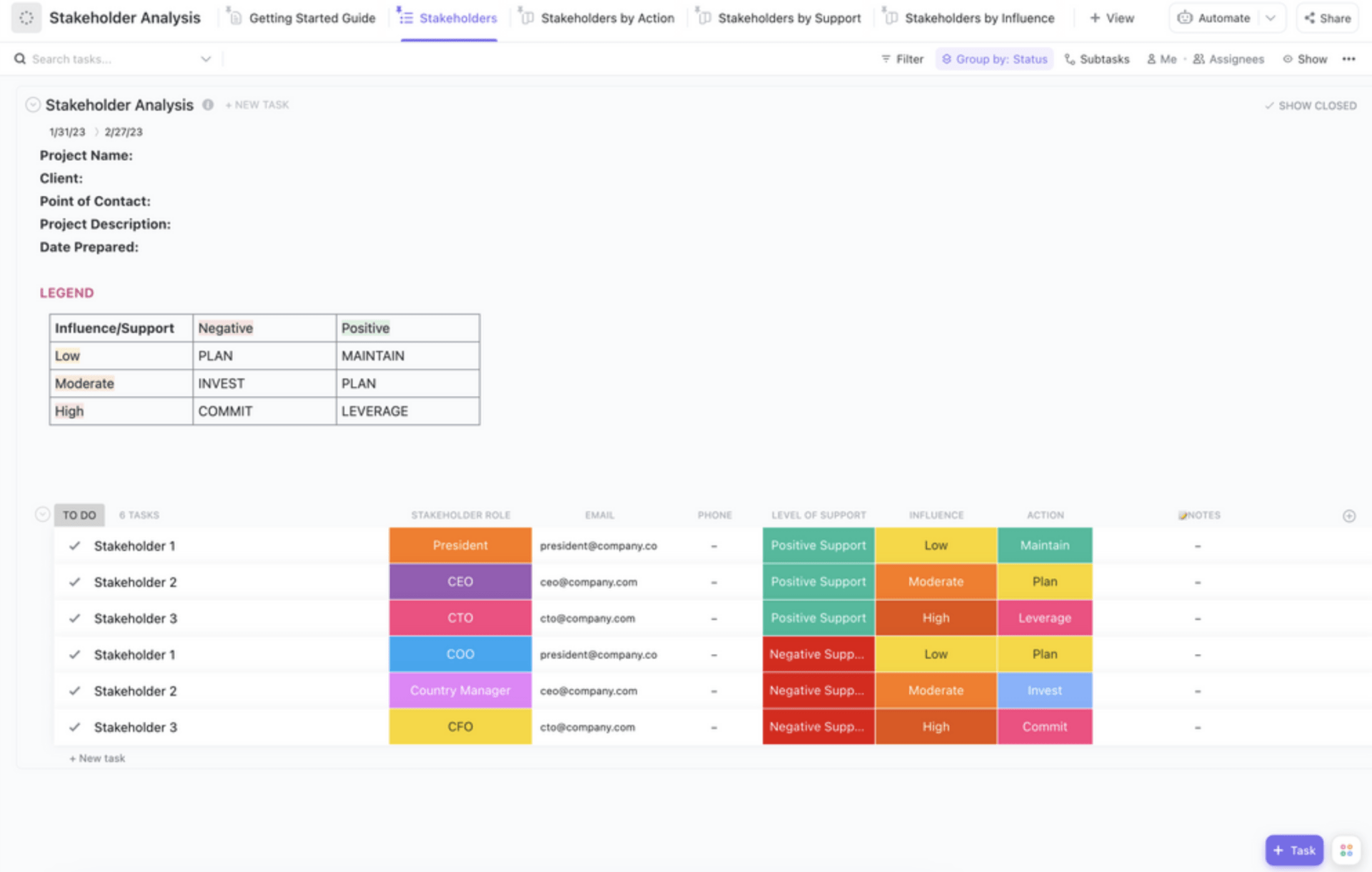
With this template, you can:
- Assign up to 7 custom attributes to stakeholders like influence, role, action, and email
- View stakeholders based on their level of influence, the amount of action they can take, or the level of support a stakeholder can provide
- Assign custom status (open and complete) to track progress
Stakeholder Map
Stakeholder mapping is another method that visually plots stakeholders on a graph based on their power (influence) and interest regarding the project. You can use a variety of stakeholder mapping templates to create this map.

ClickUp’s Stakeholder Map Template is a simple template that you can use to manage your stakeholder communication right out of the box. It includes the ability to create custom fields and views and add custom statuses to track your communication effectively. It also lets you organize stakeholders into categories for better analysis.
The next step when developing a stakeholder communication plan is to define the objectives behind stakeholder engagement . For example, if you are working with a new client, your primary goal would be to gain and establish trust with them. Another example could be communication with your internal stakeholders regarding a change in a standard operating procedure (SOP).
The right correspondence mediums in your stakeholder communication plan will make or break your stakeholder engagement efforts. As project managers, your communication channels must match your stakeholder’s preferences without impacting your communication objectives. Doing so will ensure:
- Your messages are delivered to them in a manner that is both accessible and actionable based on an individual stakeholder’s need
- Your stakeholders feel that their feedback and input are valued
Let us closely examine the various communication methods you can use to communicate with stakeholders.

Emails have been the bedrock of formal and effective communication in a business setting for decades. They should be your go-to communication method when sharing project status updates, reports, or concerns with specific stakeholder groups.
Short Message Service (SMS)
SMS is a less formal method of communication and works best when the goal is to deliver brief, quick, relevant, and time-sensitive information to stakeholders.
When comprehensive discussions or collective decision-making is required, a meeting, either in person or virtually, is the perfect medium for effective stakeholder engagement. Regular meetings should be an integral part of your stakeholder communication plan.
Reports should be a part of your communication plan as they are a great medium through which stakeholders can gain a holistic view of a project’s progress and any challenges it may encounter.
Pro tip: The key when choosing the communication methods for your communication plan is to match the method to the intended message.

ClickUp’s Communication Plan Template provides a structured and customizable framework to ensure all your information, be it project deliverable updates or communicating project management goals , is conveyed effectively to each stakeholder.
Here is what you can do with this template:
- Brainstorm ideas to create project goals
- Create messages to keep track of them and assign tasks to your team
- Categorize tasks and set up notifications to keep track of progress
Time is money, and a competitor (known or unknown) is always looking to beat you to capture the market. This is why efficiency gains can make a massive difference in the success of your project.
One tool that will help you attain those gains is ClickUp Brain. It offers three very powerful AI assistants that will help you meet your stakeholder communication and project management obligations with ease.
ClickUp’s AI Knowledge Manager will get you all the information you need regarding your project such as critical updates on tasks or information on how to perform a specific action. It can also help you summarize documents and categorize tasks based on instructions.
ClickUp’s AI Project Manager excels at automating repetitive tasks and keeping you apprised of approaching project deadlines. You can also ask it to fill data in tables, generate standups, add subtasks to tasks, etc.
Finally, ClickUp’s AI Writer for Work can write quick emails, improve your writing, and generate templates and transcripts with just a few keystrokes.
With all the pieces in place, the final step is to execute your plan. Engage as planned, seek inputs, and address any concerns that may arise throughout your communications with everyone.
For starters, happier stakeholders who feel valued can equate to a better work environment for your team. Any feedback coming in will prove beneficial in terms of lowering project risks, and finally, it can help you stay focused on the high-value objectives that can get lost in the fog of day-to-day project management.
Pro Tip : Include feedback mechanisms in your business communication plan. Two-way communication with all parties involved can be a blessing in disguise. With ClickUp’s Form View , you can embed dynamic feedback forms into your communication. This will streamline stakeholder engagement and turn feedback into actionable tasks.
Stakeholder Communication Plan Examples
Here are three examples from different industries that will help you apply what we have covered thus far in a real-world scenario.
We start with identifying and grouping all parties involved using an analysis matrix to categorize them based on their influence and interest. In this case, the stakeholders would be clients, investors, developers, and end-users.
The next step is to define your primary objective: to align all parties involved toward the common purpose, keep them informed about the progress, and seek input to improve the development process.
Now, you can lay out your communication plan as follows:
- Email : Weekly sprint reports to clients and investors
- SMS : Urgent updates regarding critical bugs or downtime
- Meetings : Bi-weekly sprint planning sessions with the development team and monthly project evaluation meetings with clients
- Reports : Quarterly progress reports for stakeholders
Sticking with the same process as above, the first step is identifying and grouping your stakeholders. In this setting, these would be your suppliers, distributors, internal teams, and regulatory bodies.
As a manager here, your objective will be to keep internal teams updated on production changes and ensure suppliers are aware of inventory needs.
Based on this, your communication plan can be as follows:
- Email : Monthly updates to suppliers on your inventory needs
- SMS : Notifications on shipment deliveries and delays
- Meetings : Quarterly meetings with distributors to assess market trends
- Reports : Annual quality and compliance reports for regulatory bodies
As a construction company, your key stakeholders will be your construction crew, clients, subcontractors, material suppliers, and local building safety officials.
Your goals here would be to keep your clients up to date on the progress of the work, communicate with suppliers to ensure your crew has all the materials it needs for the job, and keep the local authorities in the loop.
Your plan for such a setting can be:
- Email : Regular updates to clients on construction progress. (The frequency would be as per the agreement between you and your clients)
- SMS : Daily safety reminders to the construction crew or to check if any material orders need to be placed
- Meetings : Weekly on-site meetings for coordination and addressing immediate concerns
- Reports : Monthly safety and compliance reports to local authorities
How to Manage Stakeholder Communication
There are several steps you can take to communicate and manage your communications with stakeholders better, such as:
As project managers, you will communicate with people from all walks of life. When communicating with your stakeholders, you should keep a few points in mind:
- Keep it simple : Use simple language to communicate essential information. The recipient may have a different command over the language. Doing so will reduce the chances of faux pax and foster a more inclusive work environment.
- Clear, concise, and powerful: Clear instructions and simple, concise language will prevent confusion when communicating with stakeholders or delegating tasks to your team. Aim to make the most of their attention span.
- Stay composed: Being under constant stress is a part of the job; don’t let your emotions get the better of you.
These small changes can go a long way in improving how you manage your stakeholders in the long run.
Transparency is one of the most sacred stakeholder needs and must not be taken lightly. Mistakes happen, unexpected hurdles are inevitable, and not all deadlines are met. Be proactive and keep your stakeholders appraised of the situation on the ground.
ClickUp offers a host of progress report templates that will help you keep your stakeholders updated on all vital information.
The higher the transparency and trust between you and your stakeholders, the better your ability to manage them regardless of the project’s ups and downs throughout its lifecycle.
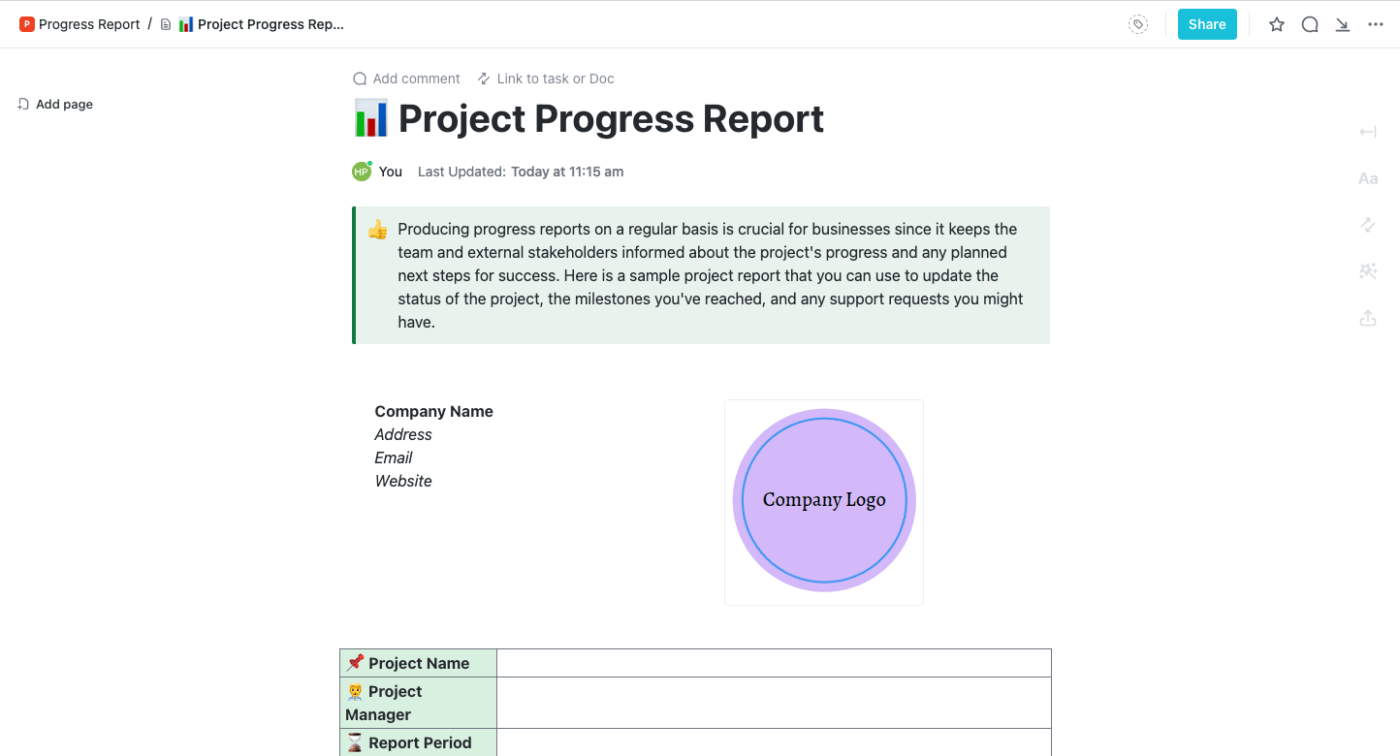
Also Read: Stakeholder mapping templates
Keeping track of all communication manually can be a challenge. Over and above the time you would have to dedicate just to this one task, you also risk missing out on crucial messages being sent out.
This is where software like ClickUp, particularly ClickUp Brain’s AI assistance, can work to your advantage for stakeholder management . Let Brain be your efficient assistant for locating any information or documents anywhere in ClickUp, summarizing it, and turning it into talking points for your communication.
ClickUp also offers numerous pre-built templates that can help manage and improve communication efforts with minimal effort from your end.
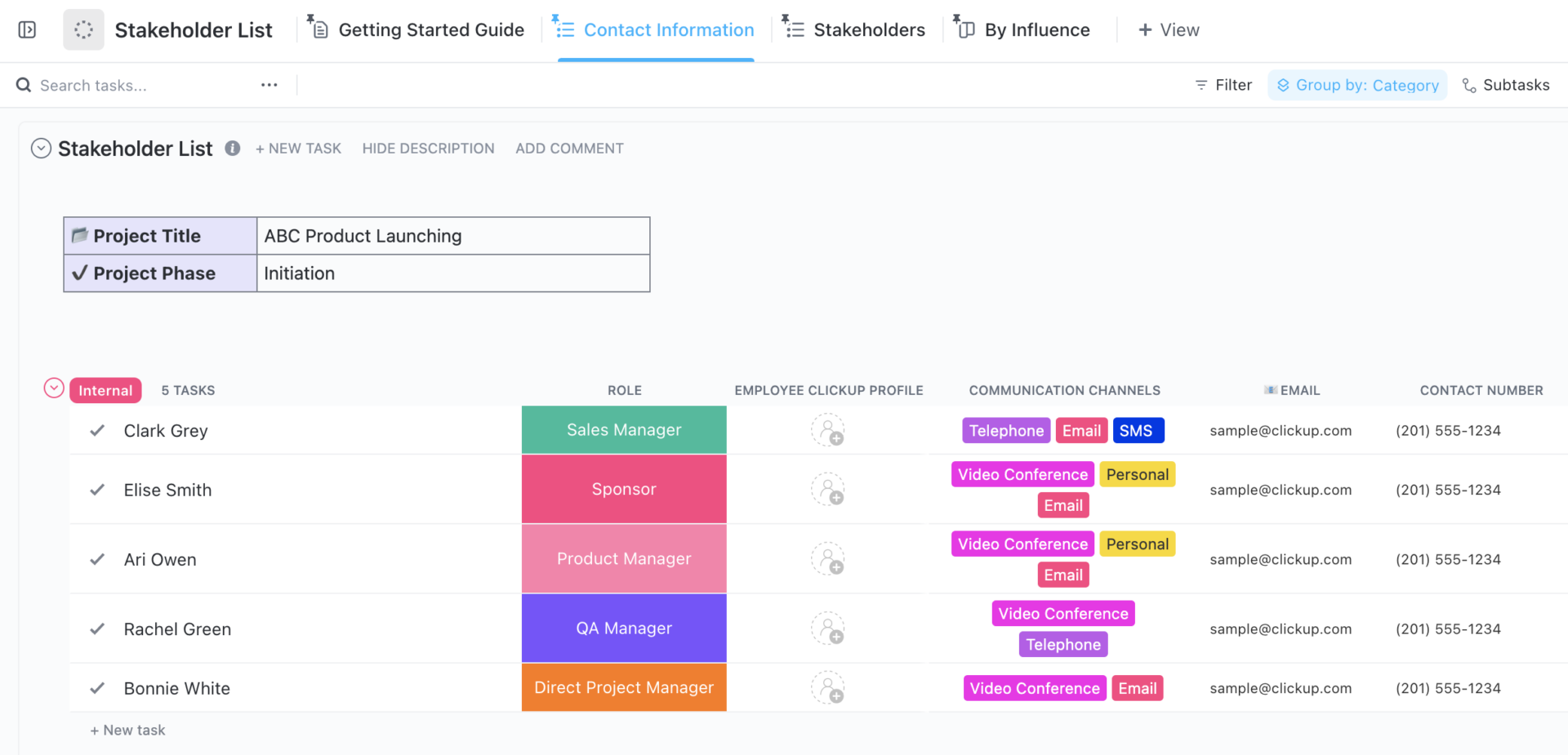
For instance, ClickUp’s Stakeholder List Template can help you organize and categorize stakeholders based on their expectations, ensuring no one is overlooked in your stakeholder communication plan.

Finally, ClickUp’s Shareholder Meeting Minutes Template can simply capture every aspect of meetings, such as key decisions, action items, and next steps, to ensure no vital information is lost, ever!
Also Read: 15 Free Project Communication Plan Templates
Communicating with stakeholders is one facet of a project or risk manager’s responsibilities that requires proactiveness, finesse, and consistency. Remember, behind the success of the best teams is a solid professional relationship with all parties involved.
However, it is easier said than done, especially when dealing with large-scale projects. Thankfully, there are tools available today that can help in this regard. A feature-rich stakeholder management software like ClickUp will help you stay on top of things.
So why wait? Sign up for free to see what ClickUp can do for you.
Questions? Comments? Visit our Help Center for support.
Receive the latest WriteClick Newsletter updates.
Thanks for subscribing to our blog!
Please enter a valid email
- Free training & 24-hour support
- Serious about security & privacy
- 99.99% uptime the last 12 months
- English
- Deutsch
- Italiano
- Français
Business Continuity vs. Disaster Recovery: What’s the Difference?
Disaster recovery and business continuity are two processes that help organizations ensure their resilience when unexpected adverse events occur. Learn more about them and how they differ.
- Cost Optimization
- Disaster Recovery

May 07, 2024
When disaster strikes, whether it’s natural or human-made, businesses need to be prepared. Business continuity planning helps organizations continue operating during or after an event, while disaster recovery planning helps them restore IT infrastructure and data after a disruption.

When the unexpected happens, poorly prepared businesses run the risk that everything could come to a screeching halt. Customers could stop placing orders, outgoing shipments could cease, and productivity can grind to a standstill. All of that leads to lost revenue, unhappy customers, and bad publicity. In some cases, it can even result in compliance failures and financial penalties.
It’s important to understand the distinctions between business continuity planning (BCP) and disaster recovery planning (DRP) because they each entail a different set of problems, priorities, and solutions.
Historically, business continuity and disaster recovery have called for complex and expensive solutions with multiple potential points of failure. Recent innovations, including Pure Storage ® ActiveCluster ™, combine simplicity and ease of use with robustness and dependability. Before we delve further into solutions, though, let’s talk about the main differences between BCP and DRP.
What Is Disaster Recovery Planning?
Disaster recovery , often referred to simply as “DR,” ensures that organizations can rebound quickly in the face of major adverse events. When a hurricane leads to widespread power outages, flooding, and workforce disruption, for example, an effective disaster recovery plan ensures that IT systems remain up and running and that operations can come back online as soon as possible.
The primary focus of DR is to restore IT infrastructure and data after a significantly disruptive event. This includes minimizing downtime, minimizing data loss, and ensuring business continuity. Readiness starts with an effective disaster recovery plan that incorporates backup systems, data replication, and testing procedures to ensure that the plan will work in practice.
What Is Business Continuity Planning?
Business continuity is somewhat broader in its scope, encompassing an entire organization’s ability to continue operations during and after a crisis. Not only does it address a wider range of functions, but it also encompasses a larger array of potential disruptions, including localized events that might simply halt operations for a brief period of time.
Business continuity plans address the need to maintain essential operational functions, manage risks proactively, and adapt to changing circumstances. When a regional storm makes travel difficult and causes short-term power outages, for example, an effective business continuity plan will have already laid out the potential impact, measures to mitigate associated problems, and a strategy for communicating with employees, vendors, customers, and other stakeholders.
Disaster Recovery vs. Business Continuity: Key Differences
So, what is the difference between BCP and DR?
Business continuity planning addresses the big picture, including a broad range of operational functions, whereas disaster recovery planning deals primarily with IT infrastructure and data recovery.
BCP extends beyond the IT department into key business processes such as supply chain management , customer service, and human resources. DR is a vital subset of business continuity because it attends to the recovery and continued operation of the company’s IT backbone.
BCP and DR have slightly different objectives as well. The former prioritizes keeping things going, even if it’s not “business as usual.” The latter seeks to restore normalcy as quickly as possible.
Business continuity planning often entails temporary measures or workarounds that are not part of the company’s normal routines. In the face of regional disruptions, for example, a company might reallocate workloads to a secondary location or contract with an outside organization to fill a gap temporarily.
In this respect, business continuity often includes plans that enable the organization to continue operations under adverse conditions. This requires planners to identify essential business functions, create manual workarounds for automated processes, and ensure that sufficient resources will be available to continue operations. In BCP, the goal is to keep things going, even if extraordinary measures are required to do so.
The objective of DR, in contrast, is to minimize downtime, restore data to the greatest extent possible, and return critical IT systems to their normal state as rapidly as possible. This typically involves detailed technical strategies for system failover, data recovery, and backups. The primary objective is a rapid return to normalcy while minimizing losses.
Because BCP encompasses a broader range of functions, it also requires a more detailed approach to scenario planning, risk assessment, and contingency measures. Testing business continuity requires that organizations simulate various scenarios to ensure that all aspects of the plan function correctly and that personnel are able to perform their roles adequately.
DRP also calls for routine testing, but such tests tend to be more focused in their scope, zeroing in on the immediate aftermath of a disaster and aiming to get systems back online within a specified target time frame.
Importance for Organizations
To ensure their resilience in the face of adverse events, organizations should have both a disaster recovery plan and a business continuity plan in place. The unexpected can happen when you least expect it, and things can change quickly.
When a cargo ship destroyed the Francis Scott Key Bridge in Baltimore earlier this year, it severed access to the port, halting operations for the businesses that operated there and disrupting supply chains for countless companies.
When Colonial Pipeline suffered a ransomware attack in 2021, there were fuel shortages in 17 states. Numerous airlines were compelled to alter their flight schedules, and drivers were faced with long lines at the gas station.
These events illustrate why it’s so important to have both a business continuity plan and a disaster recovery plan in place and to test them routinely. Even for companies with very little exposure to weather disasters or supply chain disruptions, it’s important to plan ahead. Ransomware, for example, is a growing problem for businesses of all sizes. According to SANS Institute, the number of ransomware cases increased by nearly 73% in 2023 .
To protect yourself, engage stakeholders in your organization to develop comprehensive plans for both business continuity and disaster recovery. Consider investing in technology solutions that are designed with resiliency in mind.
At Pure Storage, for example, we’ve designed our products around what we call a cyber-resiliency architecture . Pure Protect™ //DRaaS , for example, is an on-demand disaster-recovery-as-a-service solution that simplifies DR by enabling you to recover critical systems to the AWS Cloud in just minutes while maintaining full custody of your own data at all times. Purity//FA , the software heart of our FlashArray ™ solution, offers always-on data protection and lightning-fast replication. Our Evergreen//One ™ storage-as-a-service offering comes with a first-of-its-kind ransomware recovery SLA .
Pure Storage can help you fast-track your BCP and DRP readiness with solutions designed with native cyber-resiliency capabilities. Learn more about our data protection , ransomware , and business continuity and disaster recovery solutions today, or contact us to discuss your unique requirements.
Written By: Pure Storage
Related Stories

LPU vs GPU: What’s the Difference?
LPU vs. GPU: GPUs are optimized for graphics while LPUs are optimized for natural...

NPU vs. GPU
Explore the differences between NPUs and GPUs, focusing on their uses, architectures, and key...

The Power of Containers + AI: Why You Need a Data Platform That Supports Both
Containerization and AI have even greater potential when combined. Learn more about these technologies...

RTO vs. RPO: What’s the Difference?
In this article, we take a closer look at two important concepts that are...
Top Stories
Demystifying directflash modules vs. ssds vs. hdds vs. hybrid.
Home / Blogs / What Is a Business Glossary? Definition, Components & Benefits
The Automated, No-Code Data Stack
Learn how Astera Data Stack can simplify and streamline your enterprise’s data management.

What Is a Business Glossary? Definition, Components & Benefits
Product Marketer
A solid understanding of internal technical and business terms is essential to manage and use data. Business glossaries are pivotal in this aspect, facilitating improved understanding and collaboration among teams.
A business glossary breaks down complex terms into easy-to-understand definitions, ensuring that everyone in the organization, from the newest recruit to the CEO, is on the same page regarding business language. This clear and uniform understanding fosters seamless communication — an essential aspect of organizational success.
A business glossary helps:
- Simplify the onboarding of new employees by familiarizing them with company terminology.
- Provide quick access to clear definitions for effective communication in daily operations.
- Ensure consistent understanding of terminology among cross-functional teams, enhancing collaboration.
Understanding the Business Glossary
A business glossary is a repository of data-related terms and definitions specific to a company’s industry, processes, and products. It includes industry-specific jargon, acronyms, and business-specific terminologies, all systematically organized for easy reference. Its primary purpose is to promote consistency, clarity, and a shared understanding of these terms across the organization.
A centralized repository of definitions guarantees that employees, stakeholders, and partners use the same language to discuss concepts and processes. It acts as a learning resource for employees, especially newcomers and those transitioning between departments, helping them familiarize themselves with company-specific jargon. With clear definitions readily available, employees can make more informed decisions, contribute effectively to discussions, and collaborate more productively, ultimately driving organizational success.
For instance, in a retail organization, a business glossary can serve as a comprehensive reference tool containing definitions of terms relevant to the industry’s operations. Within this glossary, terms like “Inventory Turnover Ratio,” “Average Transaction Value,” and “Customer Segmentation” are defined. Each definition is tailored to the specific context of the retail sector, ensuring clarity and consistency in communication among employees across departments.
Key Components of a Comprehensive Business Glossary
A business glossary consists of four key components:
- Terms and Definitions: Unique business terms and their associated meanings within an organization.
- Reference Data: Standard information that serves as a benchmark for comparison or categorization.
- Metadata: Descriptive information that offers insights about the data, including its structure, location, and accessibility.
- Classifications: These are the categories of data sorted based on type, sensitivity, and relevance to business operations.
Business Glossary vs Data Dictionary vs Data Catalog
A Business Glossary is often mistaken for a Data Dictionary or a Data Catalog, but it’s important to note that they are not the same. All three have a unique purpose in organizing, defining, and accessing data assets within an organization.
Business Glossary
A business glossary ensures everyone in a company speaks the same language by defining key terms. For instance, in a healthcare institution, “Patient Admission” might be “the process of formally registering a patient for treatment or care within the facility.”
Data Dictionary
A data dictionary provides detailed descriptions of data elements, such as their format and meaning. For example, the “Patient ID” field in the healthcare dataset could be “a unique identifier assigned to each patient for record-keeping and identification purposes.”
Data Catalog
A data catalog serves as a searchable inventory of available data assets, making it easy for users to find and understand data. For instance, the data catalog of a healthcare organization might list datasets like “Patient Records” and “Medical Procedures,” helping teams access the data they need for decision-making quickly and efficiently.
In summary, while a business glossary focuses on business terminology, a data dictionary provides technical details about the data, and a data catalog facilitates data discovery and search.
Benefits of a Business Glossary
A well-maintained business glossary offers several benefits, including:
- Standardized Internal Communication:
Maintaining consistent communication becomes increasingly vital as an organization grows or spans multiple locations. A business glossary aligns the understanding of core terms among all members within the organization. Consistently defining terms reduces the risk of misinterpretation or confusion during discussions, meetings, or project collaborations. This clarity in communication streamlines workflows prevents errors stemming from misunderstandings, and fosters a more cohesive work environment.
- Improved Data Quality and Governance:
Access to high-quality data is crucial for making informed business decisions. A business glossary is critical in ensuring data integrity by clearly defining data collection, storage, and analysis terms. When everyone adheres to standardized terminology, it minimizes data interpretation and usage discrepancies. Moreover, a well-defined glossary supports effective data governance practices by establishing guidelines for data management, access controls, and compliance with regulatory requirements.
- Increased Productivity and Trust
Clarity in communication and understanding promotes efficiency and productivity within an organization. A business glossary provides a common understanding of terms, streamlining communication and saving time. Employees who spend less time clarifying terms or resolving misunderstandings can focus more on their core tasks and responsibilities. Additionally, a shared understanding of terminology fosters trust among team members and between different departments, as everyone knows they speak the same language and work towards the same objectives.
- Streamlined Cross-Functional Collaboration:
Many organizations struggle with siloed communication and disparate interpretations of terms across different departments or teams. A business glossary promotes cross-functional alignment by combining different perspectives and creating a joint understanding of essential concepts. When stakeholders from various areas of the organization use a common vocabulary, it facilitates smoother collaboration, reduces conflicts arising from miscommunication, and accelerates project delivery. This alignment is particularly valuable in interdisciplinary initiatives or transformational projects where coordination and synergy are critical for success.
How to Create a Business Glossary
Organizations must follow a well-planned and systematic approach to ensure the glossary is comprehensive and effective. The key steps that they should follow include:
Research and Compilation
Organizations should research to identify a comprehensive range of terms commonly used in the industry or business domain. This initial phase involves compiling an exhaustive list encompassing frequently encountered terms and those specific to the organization’s niche. Investing time in comprehensive research establishes a solid foundation for a robust glossary that accurately reflects the terminology relevant to the business landscape.
Categorization
Once the terms are compiled, organizations will categorize them into logical groupings or themes based on their functional relevance within the business operations. This categorization streamlines navigation and facilitates efficient retrieval of desired information. By organizing terms into cohesive categories, the usability and accessibility of the glossary are enhanced, enabling users to locate information quickly and effectively.
Glossary Definition
With the list categorized, the next step is to develop clear, concise definitions for each term featured in the glossary. Businesses need to craft definitions with utmost clarity, using simple language understandable to a broad audience. They should also avoid overly technical or jargon-laden explanations, opting for a language accessible to all organizational stakeholders. By articulating definitions clearly and concisely, the meaning and context of each term become simple, fostering greater understanding and comprehension.
Review and Validation
The final step is to engage subject matter experts and relevant stakeholders in a comprehensive review and validation process. This collaborative effort ensures the accuracy and completeness of the glossary, leveraging diverse perspectives and expertise within the organization. Feedback and input are solicited from stakeholders to validate definitions and identify any potential inaccuracies or omissions, thereby enhancing the overall quality and reliability of the glossary. Incorporating feedback from stakeholders validates the relevance of terms and ensures that the glossary effectively meets users’ needs.
Stakeholders Involved in Creating a Business Glossary
Creating a comprehensive and effective business glossary requires collaboration and input from various stakeholders across the organization. Here’s a list of individuals or teams responsible for creating a business glossary:
- Business Analysts: Collaborate with stakeholders to identify business needs, document processes, and define key terms in the glossary.
- Subject Matter Experts (SMEs): Offer specialized knowledge to ensure the accuracy and relevance of definitions, particularly in industry-specific contexts.
- Data Stewards: Oversee data governance aspects, ensuring that glossary definitions align with data management policies, quality standards, and regulatory requirements.
- IT Professionals: Implement and maintain technical solutions to support the glossary, including metadata management systems and integration with other enterprise systems.
- Project Managers: Lead the planning, execution, and monitoring of the glossary initiative, ensuring timelines are met. They also monitor resource allocation and ensure that risks are managed effectively.
- Business Users: Act as end-users of the glossary, providing feedback on usability, relevance, and accuracy of definitions to ensure alignment with their operational needs.
- Senior Leadership: Provide high-level support, advocating for the importance of the glossary, securing resources, and promoting its adoption across the organization.
Implementing a Business Glossary in Data Governance Strategy
Assessing the benefits of a business glossary in a data governance strategy highlights its crucial role in maintaining data consistency and compliance across the organization. Organizations need to invest in suitable solutions to implement a business glossary successfully. Using specialized resources, such as data governance platforms and metadata management systems, can significantly aid in managing and governing business glossaries.
Data Governance Platforms: These platforms serve as centralized hubs for managing business terms and definitions, ensuring data consistency across different departments. They offer features for cataloging data assets, managing policies, ensuring data quality, and overseeing metadata. Integrating the business glossary with broader governance processes enhances its effectiveness, aligning terms with data quality standards and compliance requirements.
Metadata Management Tools: These tools automate the discovery and harvesting of metadata from various sources, ensuring that your business glossary remains comprehensive and up-to-date. They standardize metadata to define data elements and relationships, ensuring a uniform understanding of data across the organization. Additionally, they track data lineage and support impact analysis, providing insights into data usage. When integrated with data governance, they enforce compliance, enhancing overall data governance effectiveness.
A Final Word
A well-curated business glossary is the foundation of effective data governance, ensuring data accuracy, compliance, and alignment with the organization’s objectives. It serves as a common language, bridging communication gaps among various departments within the company. With advanced tools and technologies, managing and maintaining a business glossary has become significantly more streamlined and efficient. These innovations have simplified the process and enhanced the overall effectiveness of data governance, paving the way for organizational success.
Astera’s data governance solution offers a comprehensive suite of features designed to streamline creating and maintaining a business glossary. With Astera’s enterprise platform, organizations can leverage AI to name their data assets and create descriptions. With an intuitive and code-free UI, Astera enables self-service data governance across the organization, empowering business users to take control of their data.
Interested in learning more? Sign up for a free, customized demo .
You MAY ALSO LIKE
What is online transaction processing (oltp).
OLTP is a transaction-centric data processing that follows a three-tier architecture. Every day, businesses worldwide perform millions of financial transactions....
Best Data Mining Tools in 2024
What Is Data Mining? Data mining, also known as Knowledge Discovery in Data (KDD), is a powerful technique that analyzes...
Data Warehouse Testing: Process, Importance & Challenges
The success of data warehouse solutions depends on how well organizations implement test cases to guarantee data integrity. As organizations...
Considering Astera For Your Data Management Needs?
Establish code-free connectivity with your enterprise applications, databases, and cloud applications to integrate all your data.

COMMENTS
The importance, purpose and benefit of a business plan is in that it enables you to validate a business idea, secure funding, set strategic goals - and then take organized action on those goals by making decisions, managing resources, risk and change, while effectively communicating with stakeholders. Let's take a closer look at how each of ...
How to Create a Stakeholder Strategy. Summary. Lately companies have come to recognize the limitations of the view that they must create value only for shareholders. Recognizing that every ...
Don't underestimate the importance of stakeholders. If you can engage most (or all) of your stakeholders, it can massively benefit both your organization and the people you impact. Specifically, stakeholder engagement can help: Empower people - Get stakeholders involved in the decision-making process. Create sustainable change - Engaged ...
Graham Kenny is the CEO of Strategic Factors and author of Strategy Discovery. He is a recognized expert in strategy and performance measurement who helps managers, executives, and boards create ...
10 Reasons Stakeholder Matter in Business. 1. Increase Your Knowledge. Increasingly, the value of a business isn't just what it owns, but what it knows. When you know and understand more, you can work smarter, make better decisions, come up with new (and profitable ideas), and increase your capabilities.
Internal plan: A shorter version of a full business plan to be shared with internal stakeholders - ideal for established companies considering strategic shifts. ... The difference may seem subtle, but it's important. Think of a business plan as the roadmap for how to exploit market opportunities and reach a state of sustainable growth.
To effectively communicate your vision and value proposition to your stakeholders, it is important to use language that is clear, concise, and compelling. This language should be tailored to the ...
Business Plan: A business plan is a written document that describes in detail how a business, usually a new one, is going to achieve its goals. A business plan lays out a written plan from a ...
A business plan contains detailed information that can help determine its success. Some of this information can include the following: Market analysis. Cash flow projection. Competitive analysis. Financial statements and financial projections. An operating plan. A solid business plan is a good way to attract potential investors.
To outline the importance of business plans and make the process sound less daunting, here are 10 reasons why you need one for your small business. 1. To help you with critical decisions. The primary importance of a business plan is that they help you make better decisions. Entrepreneurship is often an endless exercise in decision making and ...
A business plan is a crucial blueprint for a business idea, outlining its goals, strategies, and potential challenges. It serves as a roadmap, guiding startups towards success while attracting investors. Proper business planning ensures clarity, focus, and a solid foundation for both short-term actions and long-term vision.
To make this transition, leaders need to evolve how they think about their mission and how they lead. According to Hubert Joly, the former chairman and CEO of Best Buy, we need leaders who, in ...
5. Develop a plan for engagement. The goal of stakeholder engagement is to manage expectations and build relationships. This can be done through several different methods, including: Frequent communication. This is the most important aspect of stakeholder engagement. You must regularly communicate with stakeholders to update them on the project ...
Getty. A stakeholder analysis is a project management tool used to identify the project's stakeholders, issues they care about and how they will be impacted by the project. Creating a ...
In today's dynamic business landscape, maximizing value through stakeholder strategies is crucial for companies seeking long-term success. By prioritizing the needs and interests of all stakeholders, rather than solely focusing on shareholders, CEOs can create sustainable and resilient businesses. Through a data-driven approach, firms can design and implement effective stakeholder engagement ...
April 19, 2022 - 7 min read. Jessica Everitt. A stakeholder management plan is a strategy document that will help you ensure project deliverables and expectations align and that your project is seen as a success. Without a plan to regularly update stakeholders, resources, funding, employees or materials can be impacted.
A stakeholder engagement plan will be unique to your business, and should be developed with a clear view of the business's purpose and its stakeholders' priorities. View the following principles through that lens. Managing risk: Stakeholder management is an important part of your corporate risk management strategy. If stakeholders aren't ...
For stakeholders with low interest and low influence, one-way communication of essential information will likely be sufficient in most instances. This group is more influential than the low-low grouping. Although they still have a low interest in regular communication from your organization, it's important to monitor this group regularly ...
A business plan is essential as an entrepreneur. It helps you set clear goals and guidelines for how you will manage your business. A business plan may also be needed to set employee goals, obtain funding or even to sell your business one day. In this article, we discuss the importance of a business plan for entrepreneurs, as well as a few main ...
Stakeholder engagement has grown into a widely used construct in business and society research and related streams of literature. The construct has gained traction under the premise that it is highly applicable to understanding and explaining the relationships between organizations and stakeholders, such as employees, customers, suppliers, competitors, local communities and citizens, and the ...
5 steps to create an SEP. To create a stakeholder engagement plan that helps you work with stakeholders in a way they can appreciate, you'll first need to understand what their needs are and how they influence your project. Use the steps below to get started. 1. Identify your stakeholders.
Implementing a Stakeholder Strategy. by. Jack Springman. July 28, 2011. In the last couple of years, a number of HBR commentators, such as Jeffrey Pfeffer, Nathan Washburn and Dominic Barton, have ...
Subscribe. Stakeholder communication is an important skill for every project manager and organizational leader — whether they realize it or not. Communicating effectively with your stakeholders can make all the difference when it comes to building strategic relationships, increasing your influence, making smarter decisions, and managing risk.
Step 2: Analyze stakeholder influence-interest levels. High stakeholder engagement can really take your project to the next level. The best way to ensure high engagement is to create a clear stakeholder map that outlines each stakeholder's influence-interest level.
Introduction 10.1 Acceptance and Evaluation Criteria 10.2 Backlog Management 10.3 Balanced Scorecard 10.4 Benchmarking and Market Analysis 10.5 Brainstorming 10.6 Business Capability Analysis 10.7 Business Cases 10.8 Business Model Canvas 10.9 Business Rules Analysis 10.10 Collaborative Games 10.11 Concept Modelling 10.12 Data Dictionary 10.13 ...
2. Did you create a defined and thoughtful strategic plan for your business activities last year, 2023? Only 46% answered affirmatively, despite 90% seeing the need for a strategic plan.
Five Questions to Identify Key Stakeholders. Suppose you're meeting with a group of managers and staff members to determine who your key stakeholders are. (It's an important task, because with ...
A well-defined plan executed with a skilled team should be the primary area of focus when working for a successful project execution. One area of project governance that requires special attention is stakeholder communication.. That's because stakeholders have a vested interest in a project's success.
When a regional storm makes travel difficult and causes short-term power outages, for example, an effective business continuity plan will have already laid out the potential impact, measures to mitigate associated problems, and a strategy for communicating with employees, vendors, customers, and other stakeholders.
Business Analysts: Collaborate with stakeholders to identify business needs, document processes, and define key terms in the glossary. Subject Matter Experts (SMEs): Offer specialized knowledge to ensure the accuracy and relevance of definitions, particularly in industry-specific contexts.